Willem de Kooning Academy, Bachelor of Fine Art & Design
Preface
This Self-evaluation Report (SER) for the Willem de Kooning Academy (WdKA) is available in two forms, as a series of interrelated printed booklets (SER, Charts & Graphs, Selected Alumni) and an online website, where all appendices can be found, offering another way of navigating through the content. For clarity, in Standard 1, it maps out where the two diverge according to disciplinary specificity within the Majors and where they overlap through the interdisciplinary Practices built into the curriculum of the WdKA.1
Overall, the SER is the result of our efforts and reflective processes enacted from the previous accreditation and internal audits to the present. It is written from a collection of texts, policies, and oral and written feedback from various committees, teaching, managerial and supportive staff, students and alumni. It is the result of meetings to renew the curriculum, annual planning and reports, and quality enhancement mechanisms. Many of the documents have been included as supportive appendices. Each standard of the SER outlines related policies, execution, evaluation of strengths and weaknesses and suggested improvements. While a compilation gathered from different sources, the SER attempts to bring them into a cohesive and legible narrative representing the WdKA and the Bachelor of Fine Art and Design programmes. In other words, a collage of the dedicated work of many, this SER chronicles our past and ongoing efforts to foster tomorrow’s artists, designers and hybrid practitioners, who we hope will respond to the present in all its complexity and potential to shape the future in unimagined ways.
Willem de Kooning Academy
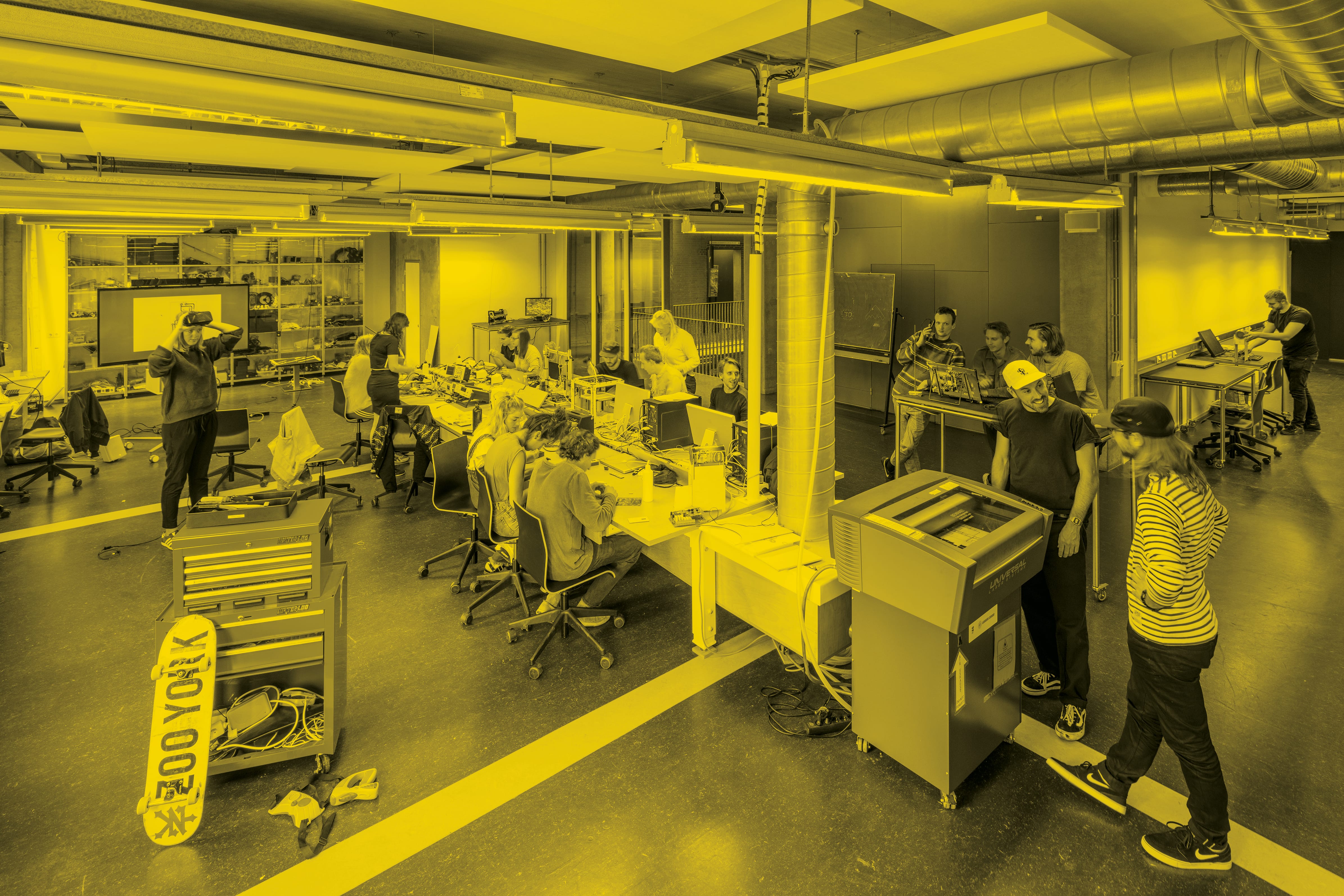
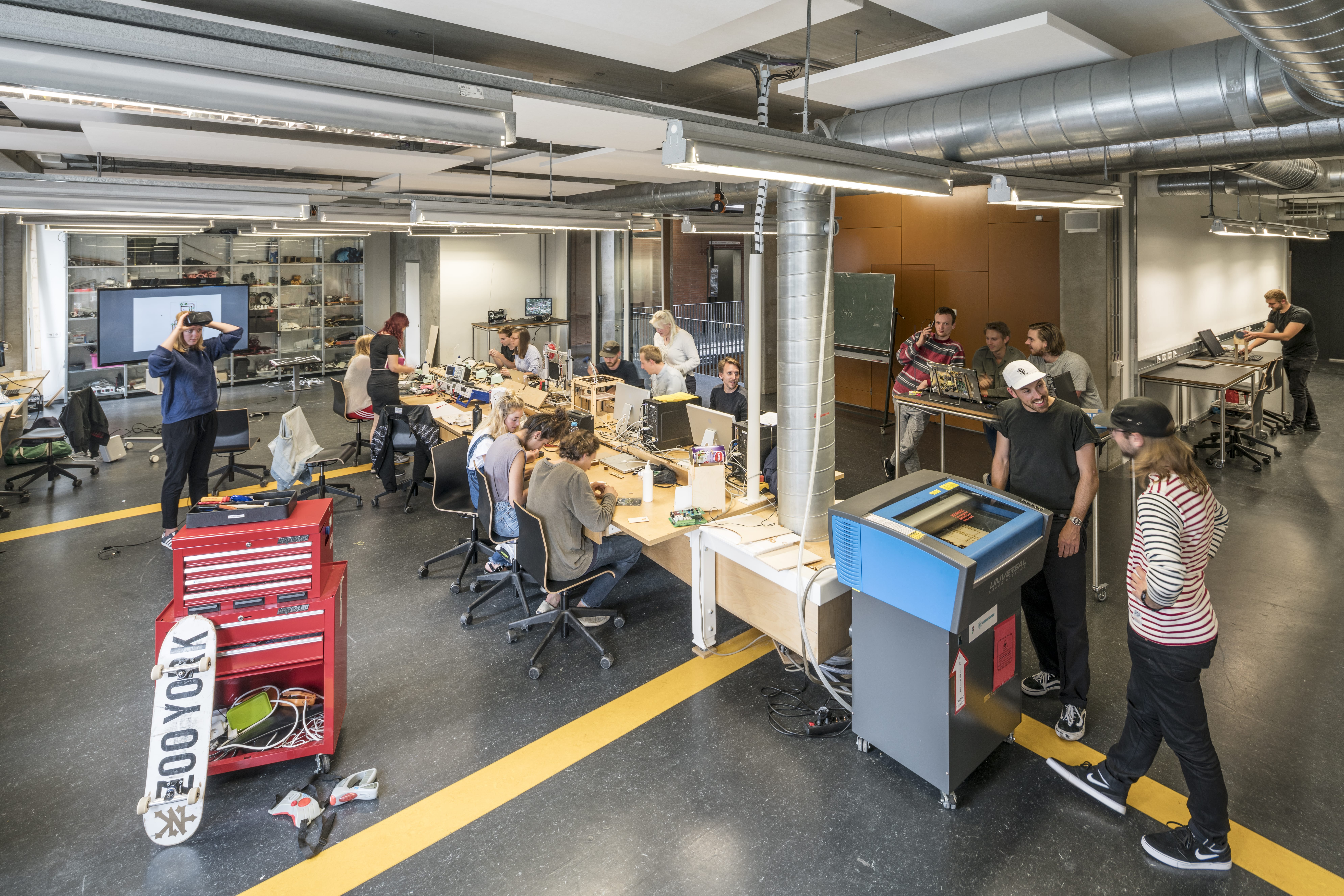
The Interaction Station: The WdKA was redesigned by TomDavid. Photo: Ossip van Duivenbode
Profile & History
“At the Willem de Kooning Academy, our goal has always been to offer students an education that is innovative, relevant and distinct from that of other Dutch and international art schools. Our recently updated curriculum provides highly individual study paths, focuses on interdisciplinarity and on current and future social issues, and paves the way for new creative professions.”
Jeroen Chabot, Dean of the Willem de Kooning Academy
The Willem de Kooning Academy
The Willem de Kooning Academy has a rich history dating back to 1773. One of the largest art and design schools in the Netherlands, it is part of the Rotterdam University of Applied Sciences (RUAS), an HBO level institution dedicated to higher vocational education across numerous professional sectors. While part of RUAS and having access to its resources and infrastructure, the Willem de Kooning Academy retains its independence in defining its goals and national and international profile.
Situated in a city that has the largest port in Europe, the academy benefits from being in a place where the local and global are inextricably linked. Its main buildings embody the contradictions of Rotterdam’s architecture. The Blaak 10 address is a former bank building which survived the World War II bombing, while Wijnhaven 61, like most of the neighbouring architecture, is relatively new. Based in the heart of the city, the surrounding urban environment is undergoing rapid changes, innovations, growth and gentrification. It is also witnessing socio-political, cultural and environmental challenges that many of our global cities face. For these reasons, Rotterdam is not just a passive backdrop to our activities, it is integral to our identity, informing how our curriculum is designed and executed, and shaping our partnerships locally and internationally.
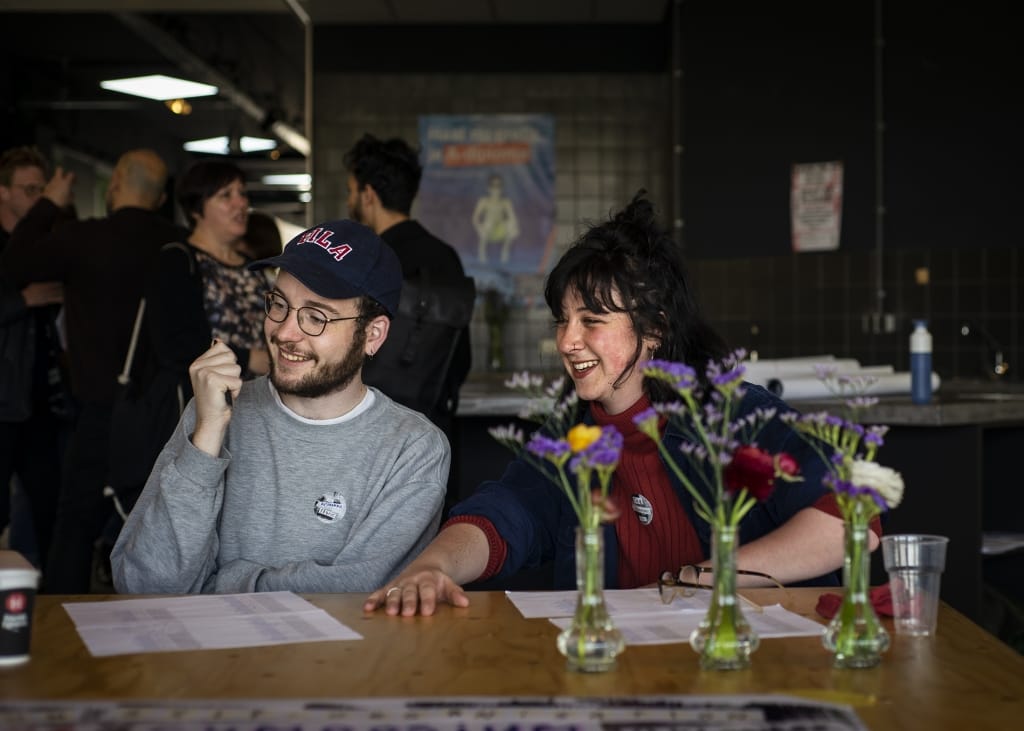
Symposium The Autonomous Fabric: On Self-Organisation. Photo: Suzie Hagens
As a cradle for what we call “creating pioneers”, the WdKA actively seeks connections between developments in the fields of art and design and broader social issues. Our graduates should be employable, but also through self-initiative, create professional paths that have not yet been forged. As pioneers, they should be educated to be entrepreneurial artists and designers who have a wide variety of talents and skills. Upon entering the professional field, they should not only have the capacity to address today’s and tomorrow’s complex challenges and so-called wicked problems, but also imagine speculative futures and possibilities.
Bachelors, Masters, Associate Degree & RASL Double Degree
All of our bachelor’s and master’s programmes contribute to an ecology of knowledge which permeates our learning, research, the diversity of resources, and facilities available at the academy. In a concise overview of the programmes, the WdKA offers the following degrees:
| Programmes | EC | Degree | Students | Delivery |
| Fine Art | 240 | B of Arts | 232 | Full-time |
Design Of which: Double Degree |
240 300 |
B of Arts B of Arts or B of Science |
1117 51 |
Full-time Full-time |
| Fine Art & Design Teacher Training | 240 | B of Education in Arts | 149 | Full-time Part-time |
| Leisure & Event Management | 240 | B of Arts | 585 | Full-time |
The two programmes under review for accreditation, Fine Art and Design, have distinct trajectories.
Fine Art offers two Majors:
Design offers nine Majors:
Next to the bachelor’s, there are five international and one Dutch master’s programmes that are a part of the Piet Zwart Institute for postgraduate studies and research. They are located at Wijnhaven and Karel Doormanhof.
|
|
|
|
|
|
|
|
|
|
Master of Arts In Fine Art and Design: Three Study Paths:
|
|
|
|
|
|
|
|
|
|
|
|
|
|
|
The WdKA offers an Associate’s Degree of Design as a part of the Rotterdam Academy, a cooperation between Rotterdam University of Applied Sciences, Albeda College and Zadkine Vocational College, which delivers a two-year programme in Arts and Crafts.
Significantly, as a part of the Rotterdam Arts and Sciences Lab (RASL), students are offered the possibility to combine theory and practice within a five-year Double Degree programme (300 EC). Students completing the RASL programme obtain two bachelor’s degrees: one from the Erasmus University Rotterdam (Bachelor of Arts or Bachelor of Science) and one from Codarts Rotterdam or the WdKA (Bachelor of Music or Bachelor of Arts).
All of the WdKA organisation, teachers, supportive staff and management work collectively to support these programmes and our students.2
The New Curriculum
Since the last NVAO accreditation in 2013, tremendous changes have taken place. The Ministry of Education, Culture and Science gave art academies the mandate to renew art education, and this resulted in a new set of competencies published in 2014 by the OBK (Overleg Beeldende Kunsten), the leading national body for art education.3 The Dutch cultural sector witnessed unprecedented economisations. As the arts reeled from these cutbacks and sought new and more robust forms of organisation, the design sector was also being transformed with the decline of large studios and receding contractual labour. This resulted in the rise of freelancers, small bureaus, self-generated assignments, and also a sense of precarity.4 Artists and designers alike sought forms of maintaining their practice through creating their own workspaces, fostering collaborative approaches, and seeking interdisciplinary connections. These efforts were done as a means not only to gain ballast against the tides of uncertainty but also to face pressing and complex societal issues, ranging from ecological sustainability, mobility of populations, globalisation, discrimination, poverty, inequality and the rise of populism, to the unforeseen consequences of technology.
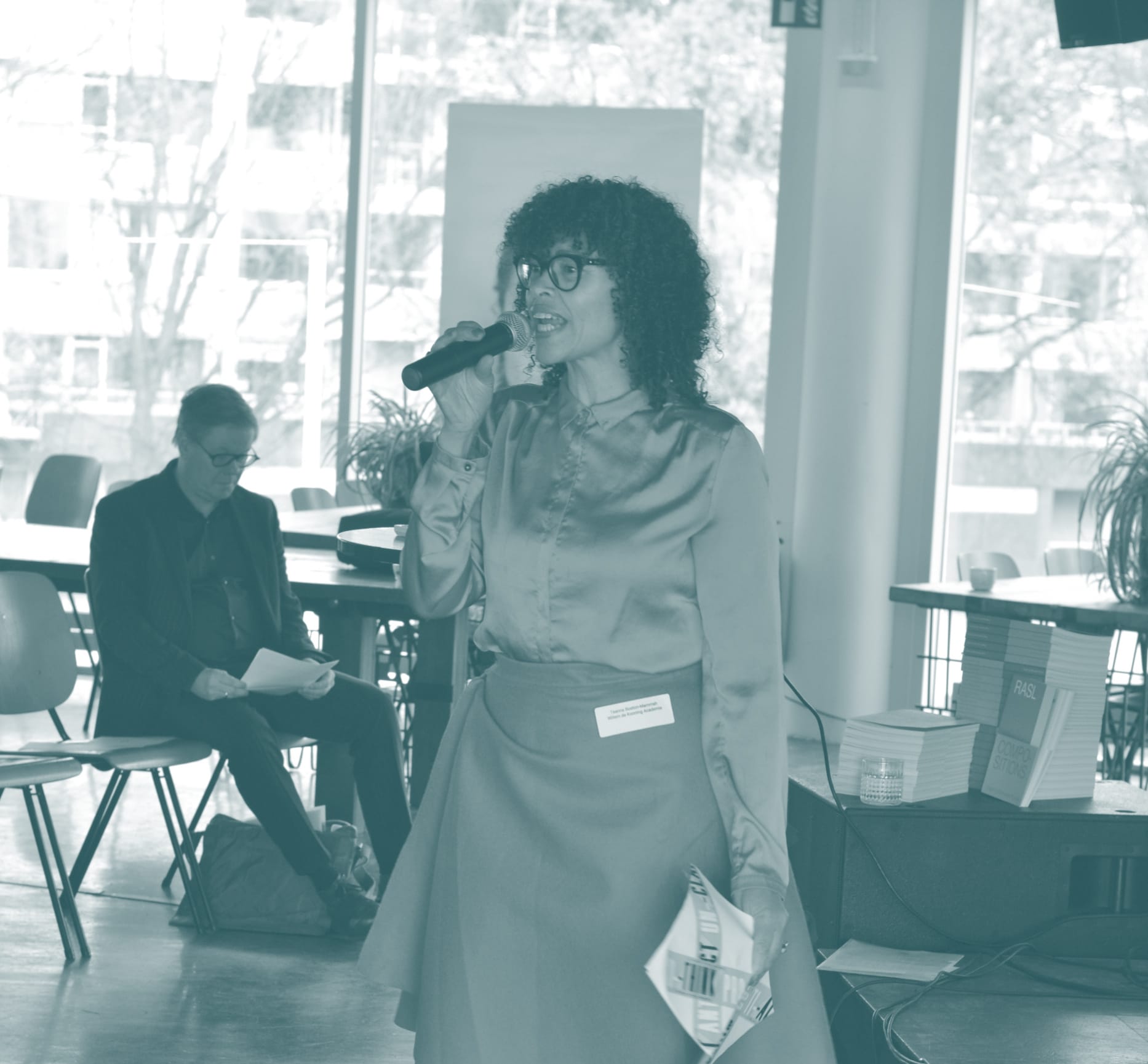
“I attempt to make students more critical of the society they are living in, to open their eyes to all kinds of disciplinary discourses that they may or may not be aware of.”
Teana Boston-Mammah, tutor, Cultural Diversity in Social Practices
From the start of the development of the new curriculum in 2013, the Willem de Kooning Academy has been reflecting and responding to these significant tectonic shifts by asking how we can better prepare students for professions that are ever-evolving and educate them to respond to these daunting challenges, while at the same time encourage them to move beyond crisis-thinking towards critical, innovative, imaginative and creative modes of tackling these issues. Through numerous meetings and discussions, we asked ourselves what kind of curriculum, learning environment, and resources are required to fulfil our ambition of creating pioneers.
Through a series of brainstorming sessions with teaching and supportive staff and meetings with our partners5, we looked at the challenges our graduates face and built on recommendations from organisations such as the OBK on a national level and ELIA and Cumulus on an international level. We analysed the potential of our art school, its alignment with our values, and questioned what had become convention. In other words, reinventing the art school was not driven by innovation for innovation’s sake, but driven by specific aspirations and educational, professional, social and environmental urgencies. Next to disciplinary knowledge, we understood that hybrid, interdisciplinary and transdisciplinary approaches should be fostered for practitioners to tackle today’s complex issues.
As a result, the academy established a set of priorities within the curriculum that are aimed at providing students with the knowledge and skills to build imaginative and sustainable careers:
interdisciplinarity
project-based and competency-driven learning
research and research through making
entrepreneurship
media focus and literacy
internationalisation
1. From disciplinary to interdisciplinary: During the arc of their studies, students begin with their own discipline, called Majors, and as they progress, they select from one of three interdisciplinary orientations called Practices. These are: Autonomous, Commercial and Social Practices. Each of these has an accompanying set of Minors that are chosen in the fourth year.
2. Project-based and Competency-driven Learning: Through project-based learning, students work on real-life assignments, develop competencies in context and through making and designing projects, and learn to understand and define their own professional role through iterative processes. Students work both independently and collaboratively under the guidance and supervision of their tutors or tutorial teams in connection with Stations.
3. Research: The WdKA operates from the perspective that art and design research produces new forms of knowledge and practices, and is a catalyst for innovation and transformation.6
Research is fostered through the following:
The Stations: These environments, around which our curriculum fundamentally revolves, support iterative processes, prototyping, research through making and research trajectories such as We Make Research, Critical Making and Hybrid Publishing.
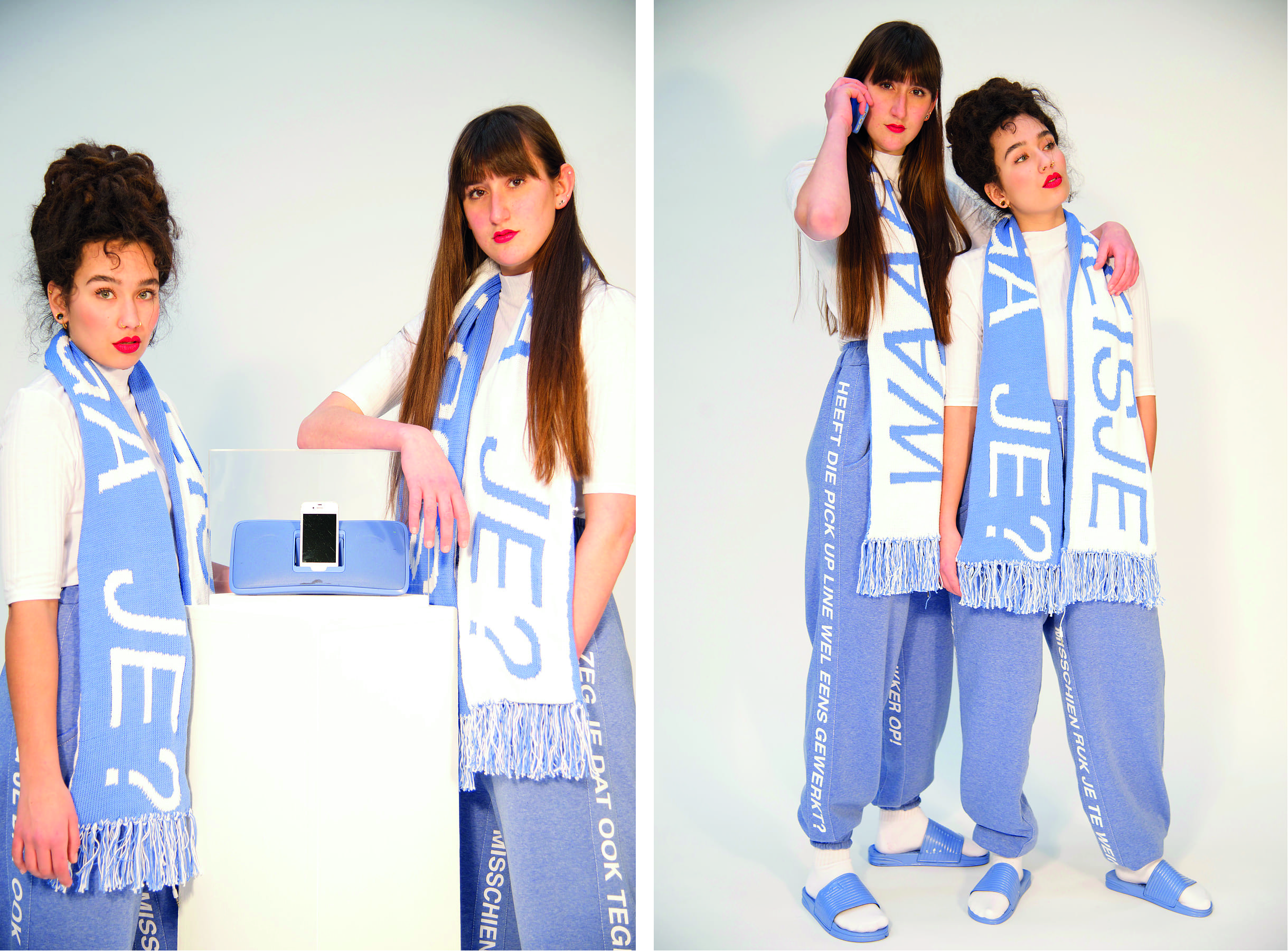
Nu ook Offline (Now Offline Too), Esther van Brakel and Annebel de Kok (Social Practices/Fashion Design)
The Practices (Autonomous, Commercial and Social): These constitute main areas of research and have resulted in projects such as The Autonomous Fabric, Beyond Social and Retail Innovation in Rotterdam.
Our Research Professorships (Lectoraten): These include the professorships on Autonomous Practices (Florian Cramer), Social Practices (Michelle Teran), Commercial Practices (to be filled), and a joint research professorship on Biobased Art and Design (Elvin Karana) shared with AKV|St.Joost, Avans University of Applied Sciences. The professorships are a part of WdKA's Research Station, and Research Professors are encouraged to collaborate with colleagues from Codarts Rotterdam and Erasmus University Rotterdam in the Rotterdam Arts & Sciences Lab (RASL).
Senior Research Lecturers: The WdKA identifies two profiles concerning Senior Research Lecturers.
- The Course Directors of the master’s programmes actively initiate research based upon the artistic realm of their specific profiles. Through this research they are able to develop their programmes and to maintain an international network of professionals in their research and course context. They consult and actively engage the Research Lecturers in their research.7
- The WdKA Bachelor Senior Research Lecturers are all engaged with the Practices. At this point, we have accomplished having Senior Research Lecturers in Autonomous, Social and Commercial Practices, and their research informs and deepens the Practices. The Senior Research Lecturers are part of the Curriculum Committee, which bridges research and education, and they are key figures in the teaching teams.
RASL (Rotterdam Arts & Sciences Lab): Founded in 2016, RASL is a groundbreaking initiative that is an important part of our research culture. It is a collaboration between the Willem de Kooning Academy, Codarts and Erasmus University. RASL is a platform in which the arts and sciences, students and teachers, education and research meet each other. Promoting knowledge exchange, it is a network for experimentation that stimulates new forms of collaboration. The Lab is characterised by three core elements: the Double Degree, collaborative research and creative learning. Its research examines the relationship between the arts and society in a transdisciplinary way. In addition to establishing an arts research network, it offers a unique opportunity for joint research, developing shared vocabularies, visionary approaches, and contexts for the arts to flourish. Operating on a local, national and international level, RASL works from the understanding that the arts are vital to society and can play a constructively transformative role in shaping the future. RASL acts as a catalyst for innovative research that blends academic and artistic research, or theory-driven and practice-based research pertaining to the arts, culture and society.
4. Entrepreneurship has become integral to our teaching, through project-based education that instils project management skills and is embodied through the Business Station. In the Business Station students learn to find strategies to connect to the world outside of the academy; make an impact with their work, by connecting and acting on values and business context awareness; discover how to control and lead within competitive markets, both nationally and internationally; and receive advice on dealing with clients, negotiating contracts, balancing budgets, and finding partners and resources. In addition to specific programmes and modules, the Business Station offers a wide range of activities about entrepreneurship and events related to starting a business.
5. Media Focus: Understanding the importance of digital technologies, many of the Stations provide state-of-the-art facilities and expertise (Drawing-, Image & Sound-, Publication-, Interaction-, Material-, and Fabric Stations and the BlueCity Lab). Software, hardware, technology, equipment, and diverse machinery are made available for students to realise their projects. This hands-on approach is coupled with the support of the Research Station and theoretical courses integrated into the curriculum, where social, political, cultural and environmental contexts are also considered. Within the WdKA, Media Focus means using technologies critically while also understanding their impact, effects and related literacies.
6. Internationalisation: This is facilitated by bringing in foreign students through our exchange programmes, teaching in English as well as Dutch, providing English language support for students and staff, and making sure essential learning material and resources are available in English. Internationalisation has also been accounted for in our staffing across the bachelor’s and master’s programmes. We have also fostered strong international partnerships with institutions such as the Maryland Institute College of Art in Baltimore, Emily Carr University of Art and Design in Vancouver, St. Lucas School of Arts in Antwerp, Faculty of Fine Arts Concordia University in Montreal and the Moholy-Nagy University of Art and Design in Budapest.
To further this end, and to promote knowledge exchange and enhance our international profile, the WdKA hosted the 2018 ELIA Biennial Conference, ‘Resilience and the City’. A collaboration with Codarts and ELIA, over 460 people attended from art schools across 36 countries. There were keynotes and numerous peer-reviewed presentations held in mobile, parallel sessions. The three-day conference was a moment to showcase selected student, alumni and staff research. It was also an opportunity to talk both formally and informally to colleagues about the challenges facing art education. Currently, to continue building on this synergy, the Dean Jeroen Chabot now serves on the Executive Board of ELIA with a continued commitment to arts education and building international knowledge-sharing networks.
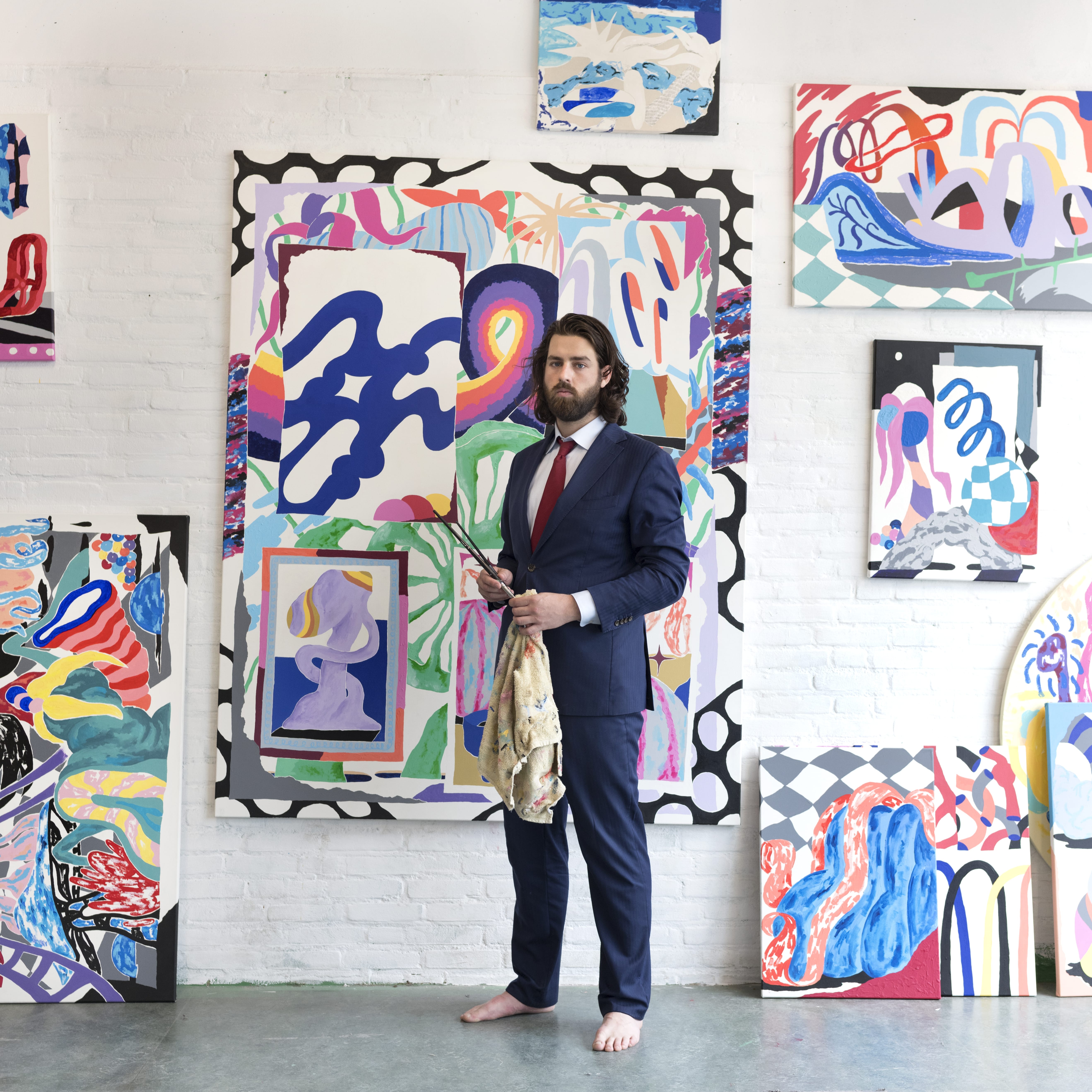
Reinier Landwehr (Autonomous Practices/Illustration). Photo: Gert Jan Pos
Evaluation & Improvements
Since the renewed curriculum, our ambitions are currently high and wide-ranging, but this also poses certain challenges. When audited by EQ-Arts in 2017, the panel noted: “The WdKA has developed a strong and distinctive strategic mission and vision. Staff and externals have been involved in the building of the new curriculum and the facilities to fully realise the new programmes. There is a clear sense of ownership, commitment and conviction about the value of the new mission from the academic and technical teams.”8 They also acknowledged the risk of “change fatigue” and staff annual surveys have indicated that there is a sense that the workload is too heavy. In response, we have implemented Drive and Development Weeks that give staff time for reflection in the development of their lessons. We have also used our Education Days to support staff in areas of assessment-, project- and competency-driven teaching, and research and collaboration. The Education Station also offers different courses and resources. Nonetheless, the workload remains an issue and we are working to structure more streamlined approaches.
The EQ-Arts Audit panel also noted that while the WdKA has international ambitions, much of the information and documents for staff and students were still in Dutch. Subsequently, to address this disparity, all key documents were translated into English and made available within the virtual learning environment of MyWdKA. The academy has also formulated a clearer policy with regards to working within an international classroom/environment and offers English support for staff and students. Also, effort has been put into hiring international staff. Most recently, new international staff members were recruited to fill the positions of the Head of Social Practices, the Course Leader of Graphic Design, the Research Professor of Social Practices, and many teachers and Station instructors. However, based on student feedback, there are still improvements to be made in terms of enhancing English language skills. While it is important to acknowledge that such cultural changes take time, in terms of wholly transitioning into a fully international learning environment, all efforts within means are being made in this direction to ensure that it happens.
The EQ-Arts panel also recommended that the WdKA better translate its Quality Assurance Handbook, which was predominately tailored to the larger RUAS framework, into a form more appropriate to the culture of the WdKA. To this end, two Quality Assurance employees were hired in 2018 and a new Quality Assurance protocol and handbook has been drafted and will be fully operational in September 2019.9
Although not addressed in the EQ-Arts Audit, the WdKA and the NVAO in its 2013 accreditation found that the Research Professors needed a closer relationship to the learning environment. From 2012 to 2018, the Art and Visual Culture professorships were part of the external RUAS research institute, Creating 010. As of January 2019, for better cohesion of our learning environment, all Research Professorships on Art and Visual Culture became a part of Willem de Kooning Academy. Although a recent change, the aim is that the professors will collaborate with students, teachers and external partners, and strengthen WdKA’s cross-disciplinary art and design curriculum in the Practices.
Communication within a large organisation with complex curricula remains a challenge on many levels. While the academy has tremendous resources, support and activities, getting the information in circulation is at times difficult. Since the 2017 EQ-Arts Audit’s recommendation that our communication improve, the WdKA has implemented a regular newsletter sent out to staff and students via email. Information screens have been placed in the hallways of our buildings, and MyWdKA, the virtual learning environment, has been vastly expanded to cover an array of issues, ranging from general Curriculum Descriptions, assessment criteria, what is available at the stations, coaching, scheduling, and announcements of public and semi-public events. Recent student surveys through Quality Assurance have noted an improvement from previous years on this front, but work on further clarifying the structure and content of MyWdKA continues to be addressed.

"I am inspired by paradoxes."
Robert van Raffe, Course Leader, Illustration Major
Standard 1: The Intended Learning Outcomes
Fine Art & Design Competencies:
The profile for the final competencies, sometimes known as exit qualifications, for both Fine Art and Design were established in accordance with national and international qualification frameworks:
As a whole, the WdKA curriculum12 for Fine Art (CROHO CODE: 39110) and Design (CROHO CODE: 39111) fosters a set of seven final competencies that enable students to enter their professional field, work on their own or in interdisciplinary collaborative teams, and on commissioned or self-initiated projects. These competencies are:
Creative ability
Ability to reflect critically
Ability to grow and change
Organisational ability
Communicative ability
Context awareness
Collaborative ability
Through disciplinary Majors and interdisciplinary Practices with their related Minors, or the Honours Programme, students gain professional theory and knowledge, and cross-media skills and attitudes relevant to contemporary art and design. For each module, learning outcomes are described and competencies are incrementally embedded in the curriculum through Curriculum Descriptions and Lesson Plans.13 To ensure that learning outcomes and competencies are adequately harmonised, synchronised and covered, the Curriculum Committee reviews these plans on a regular basis. Competencies are also mapped across a four-year learning trajectory in relation to Majors, Practices and their related Minors.14
Design Majors
Advertising: The WdKA is the only art academy in the Netherlands that offers a major in Advertising. In this programme students learn to become all-around advertising creatives who are the link between clients and media communication strategies.
Animation: The Animation programme combines movement, narrative, sound, technology and visuals. It is not merely taught as a technique or genre; it is a means of communication. Students become professionals who innovate new technologies, explore the boundaries of animation, and tell relevant stories that resonate with contemporary society.
Audiovisual Design: The Audiovisual Design programme prepares students to design using moving image and sound. The programme enables students to become professionals in Audiovisual Design who play a key role in providing information, in a wide-ranging field from education to the entertainment industries.
Fashion Design: In the Fashion Design programme, students learn to develop and apply knowledge and artisanship in order to forecast fashion trends, push boundaries and work within the fashion industry.
Graphic Design: The Graphic Design programme educates designers who are engaged, critical, curious and able to relate to the public and clients from an artistic, critical and independent position. They are taught to understand the responsibility and power of graphic design and are able to relate to social, cultural, political, commercial and technological issues in contemporary society.
Illustration: The Illustration programme prepares visual specialists who interact with audiences in an artistic, innovative and clear way. Projects highlight different aspects of contemporary illustrative practice: telling and sharing stories, the balance between artistic and commercial illustration activities, the impact of illustration on people and society, and future opportunities in illustration.
Lifestyle Transformation Design: Within the Lifestyle Transformation Design programme, students conduct research on the conscious and unconscious behaviour and needs of human beings – groups as well as individuals – and on their identities and values in relation to the given context, society and economy. Lifestyle transformation designers formulate innovative and wide-ranging solutions and/or ideas for complex market challenges focusing on the transformation of lifestyles or the market itself.
Product Design: Within the Product Design programme, students examine the relationship between products and their users. Students explore the consequences of designing, such as environmental and social sustainability. They are educated to be experimental, research-driven, collaborative and entrepreneurial design professionals who are able to imagine how products can change our future.
Spatial Design: In the Spatial Design programme, students consider the urban environment as well as indoor and outdoor spaces on a small and large scale. It is a discipline and professional field that creatively combines cultural and artistic awareness, social engagement and economic responsibility.
Fine Art Majors
(De)Fine Art: Operating from the premises that art exists within a network of cross-references and the artist reflects upon the world at large, the (De)Fine Art programme encourages students to define and redefine what art is – or can be – in relation to society. Graduates are professionals who have a grasp of artistic research, concept development, relevant modes of production, communication and presentation of their work, as well as entrepreneurial skills related to the domain of the arts.
Photography: Within the Photography programme, students are taught the uses of photographic images and the medium itself, by developing new ways of thinking and seeing. Upon entering the professional field, they possess knowledge of the language and general meanings of images, and can create images from their own artistic vision and in relation to photographic language within visual culture.
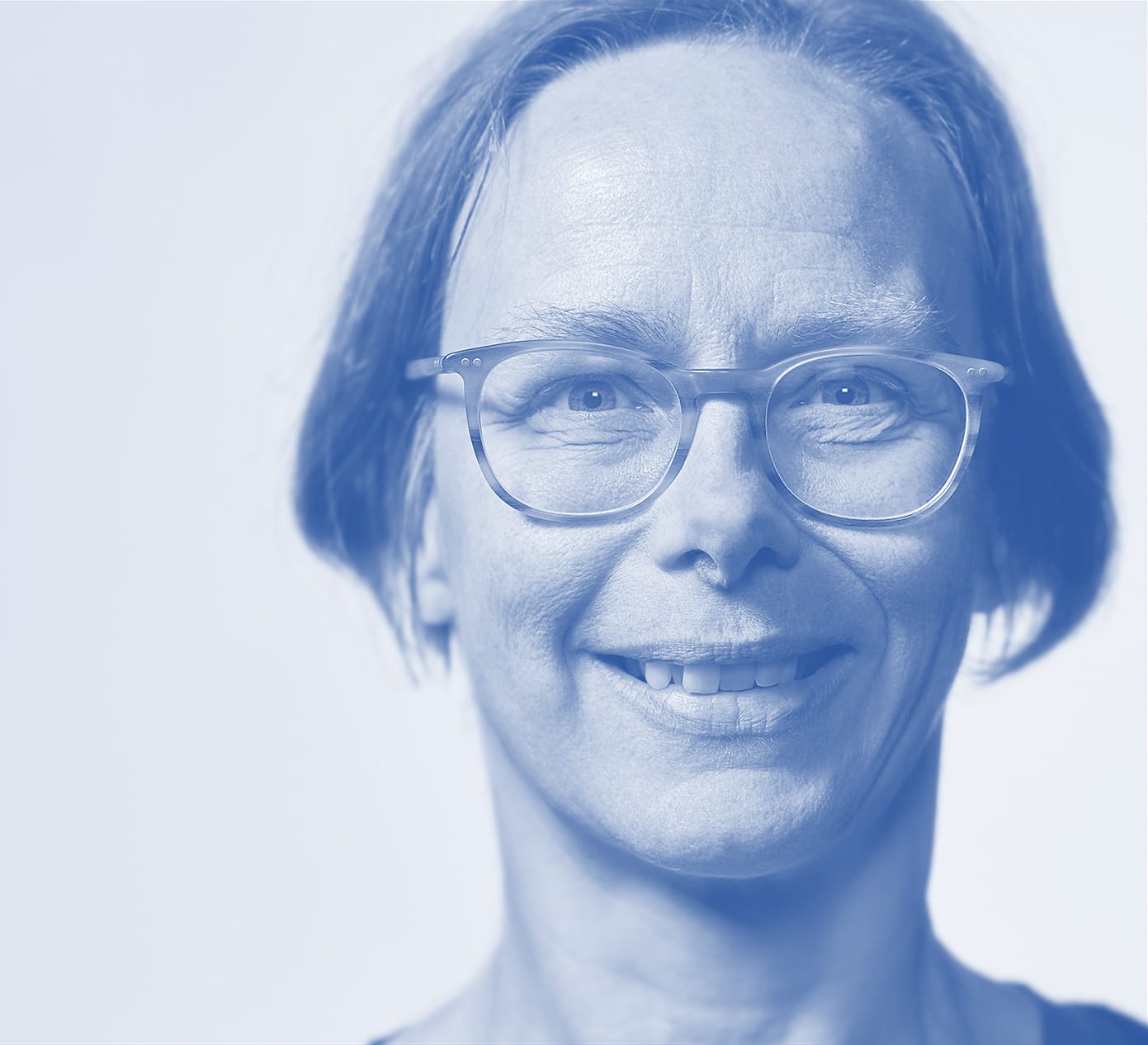
“My goal as a tutor is to have strong, critically aware young artists graduating from our academy, people who dare to question art and what art does in society – because I think art is always in relation to society, even when it rejects the mainstream. I love to teach because every year my students surprise me with their ideas and questions: they make me question my assumptions, so together we create a learning community.”
Karin Arink, Course Leader, (De)Fine Art and Photography Majors
Three Practices & Related Minors
On a curricular level, during the course of our four-year education programmes, the emphasis gradually shifts from disciplinary specialisations towards the Practices, which are more interdisciplinary. Building on the foundation of a student’s chosen discipline, there are three Practices from which a student can choose: Autonomous, Social and Commercial. The Practices, accompanied by related Minors, can be understood as different orientations in which students situate themselves within their chosen discipline. Each is driven by its own specific vocabulary, context, research methods and criteria.15
The Practices focus on new challenges in the field of technology, the use of public space, the need to engage the public, and a changing international context. Students work on real-world practical assignments which transcend the boundaries of their professional discipline. In the Practices, there is no longer any distinction between art and design; each discipline is active in its own way within the arena of public space and cultural production. In the final phase, students graduate in the Practice which identifies their professional orientation.
Autonomous Practices: Within the visual arts, the concept of autonomy is no longer the exclusive domain of fine art, but can be applied to any artistic discipline: autonomous fashion makers, autonomous graphic designers, autonomous product designers, autonomous cooks and food designers, etc. The concept of autonomy also includes other critically driven, self-organised activities, including non-institutional education, autonomous political activism, and critical engagement with technology.
The WdKA’s Autonomous Practices are based on the understanding that art and culture no longer take place exclusively in recognised cultural institutions, but that the most interesting contemporary developments are now to be found in the capillaries of society, often in informal and underground settings. This is where experimentation takes place and where new initiatives arise; this is where new audiences, who have little or no access to the established system of cultural institutions, can be reached.
Related Minors: Critical Studies, Public & Private, Digital Craft, Hacking
Social Practices: At WdKA Social Practices, the notion of accountability for contributing to a more equitable society within the means of the planet is fundamental to social art and design. At its core lies the necessity to abandon the market/state duopoly of the First and Second Industrial Revolutions, and the market economy that is based on the assumption of unlimited growth and the fair functioning of the free market. The commons have been proposed as a generative paradigm to step outside of the dominant discourse of the market economy. The commons are a social system for the long-term stewardship of resources that preserves shared values and community identity. Developing such stewardship is at the core of the practices of social practitioners.
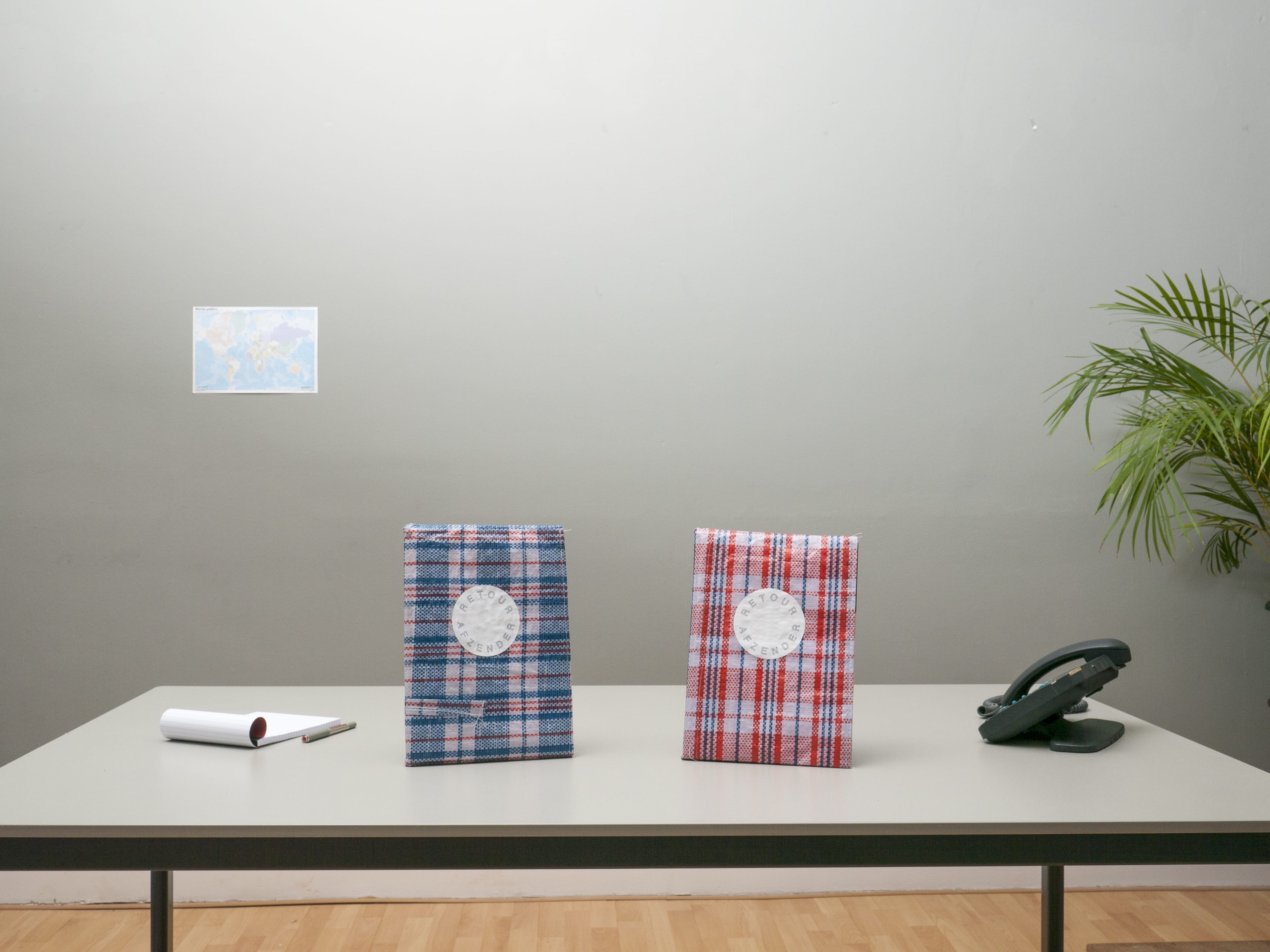
Return to Sender (Retour Afzender), Lou Muuse (Social Practices/Photography) A bilingual Hybrid Publication of the interactive website www.retourafzender.eu Graphic design: Studio Eyesberg
Dealing with complex issues requires a multidisciplinary approach; if an answer to a specific issue could be found within the traditional framework of one specific discipline, that answer might inadequately deal with the complexity of the issue. Over the past century or so, society has developed through ever-increasing specialisation. However, as we now face inordinate transformations and crises in a more complex world, the time has come for all specialisations to reconnect again so that they can more effectively face broader issues. Social practitioners cooperate with others, not only with other creative practitioners, but also with scientists, activists, users and policy makers.
The questions which the graduates of the Social Practices deal with are: What is my position as a citizen, artist, designer or educator within society and what is the engagement and purpose of my professional practice? Who is directly or indirectly involved in my practice, and how do I shape this involvement? How does my practice affect others, the other side of the world, society at large, the planet and future generations? How can I keep developing my practice into a professional pathway of radical change in existing economic, social or ecological systems? How does one develop an ethical approach to real-world encounters that do not reproduce the inequalities inherent in existing power relations?
Related Minors: Cultural Diversity, New Earth, Powerplay
Commercial Practices: The Commercial Practices explore the meaning of new economic contexts, like the ‘Next Economy’, for art and design practices and consider possible roles artists and designers can have in shaping future market-driven scenarios. The concept of the ‘Next Economy’ refers to the redefinition of production, transaction, distribution and authorship/ownership in a constantly changing world, fused by technological disruptive innovations. This economic paradigm shift affects the way people relate to industry, nature and society, and is expressed, amongst others, as a crises of natural resources, in hierarchical changes between industries, producers and consumers, and new modes of production, consumption and emergent markets.
In this scenario of economic and industrial shifts, the roles between designers, producers, companies and consumers or users are changing radically. What has traditionally been perceived as innovation (top-down strategies, highly structured innovation processes) is now changing into a more bottom-up approach. This changing landscape creates new opportunities and roles for prospective designers and artists. Creative input has never been so important within businesses, traditional and new ones, as it is today.
The Commercial Practices explore how artists and designers can position themselves in this ‘Next Economy’. It might require a form of ‘Next Design’, an artistic approach that relates and responds to this transforming society, culture and economy from a perspective that originates in aesthetics, imagination, entrepreneurship and critical reflection.
Related Minors: New Frontiers, Branding, Data Design
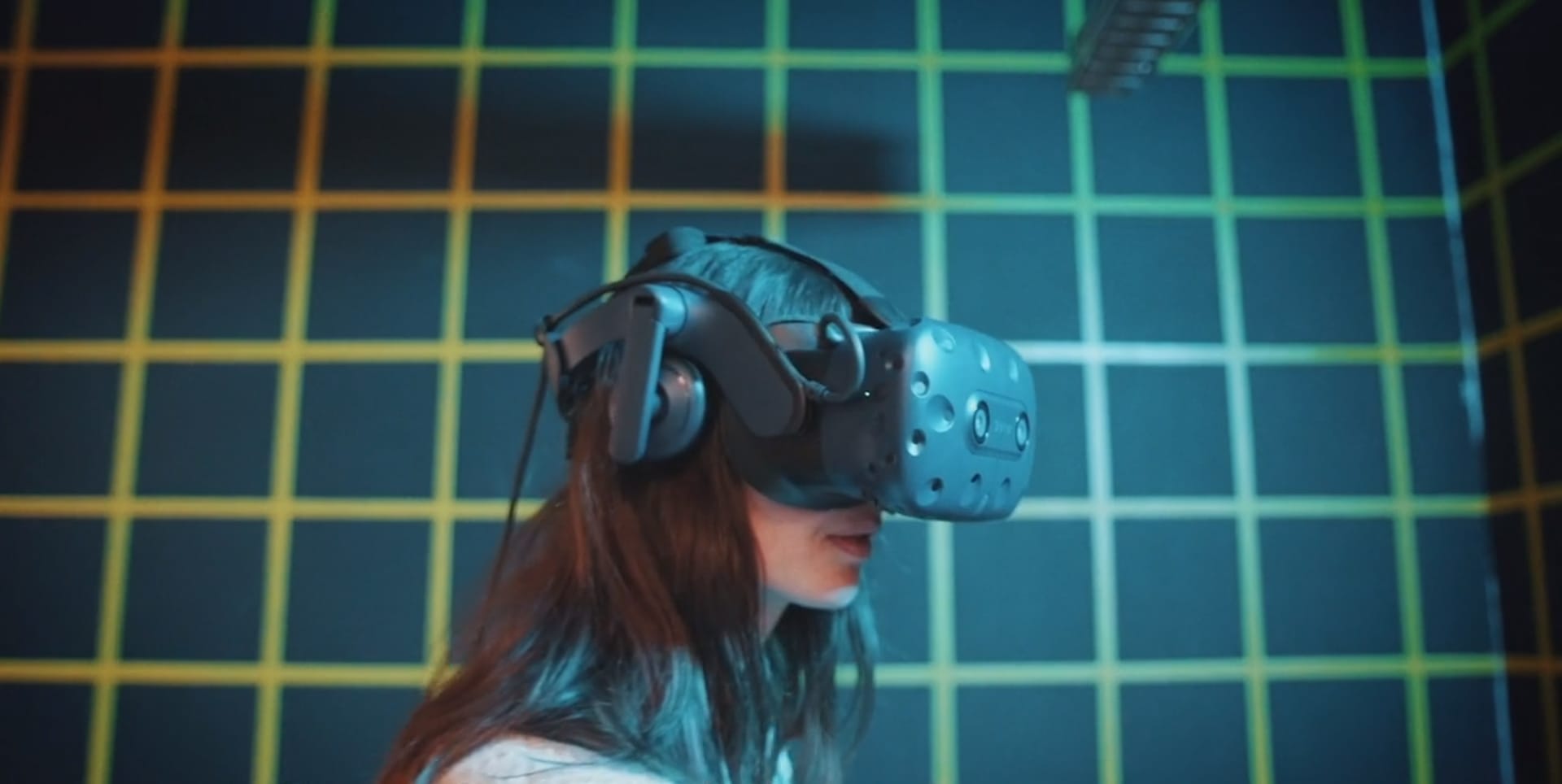
“Every Station is unique. The amazing thing is that if you have an idea for your project, there is always a Station you can work in and people who will assist you. Sometimes I can be found in the Fabric Station, even though I am not a fashion designer. I love working in the Publication Station where you have a lot of old printing methods like silkscreening, lithography, etching, lino and risograph printing. I like to translate the digital into analogue and vice versa, and so I also like to work in the Interaction Station.”
Maxime van Strijland, fourth-year student, Commercial Practices/Graphic Design Major
Other Programmes
Honours Programme: The Honours Programme is a student-driven study pathway. Working alongside senior lecturers, research professors and external experts, students work on complex and self-formulated societal questions. Within this context, they are asked to develop their own learning path and reflect upon it, as well as to investigate, coordinate, collaborate, experiment and create new knowledge. At the end of their studies and having successfully completed the Final Assessment, students receive a ‘Declaration Honours Degree’. This is an addition to the standard diploma which indicates that students have mastered the RUAS competency profile “Learning to Innovate”.16 The Honours Programme is closely related to existing research frameworks, such as the Research Professorships and RASL (Rotterdam Arts and Sciences Lab). 17
Related Minor: Visual Culture
The RASL Double Degree Programme:
Students pursuing the Double Degree can select any of the above Majors, Practices, Minors and Honours Programme; however, their theoretical and academic research requirement is fulfilled through the Erasmus University and results in concurrent diplomas from each organisation.18
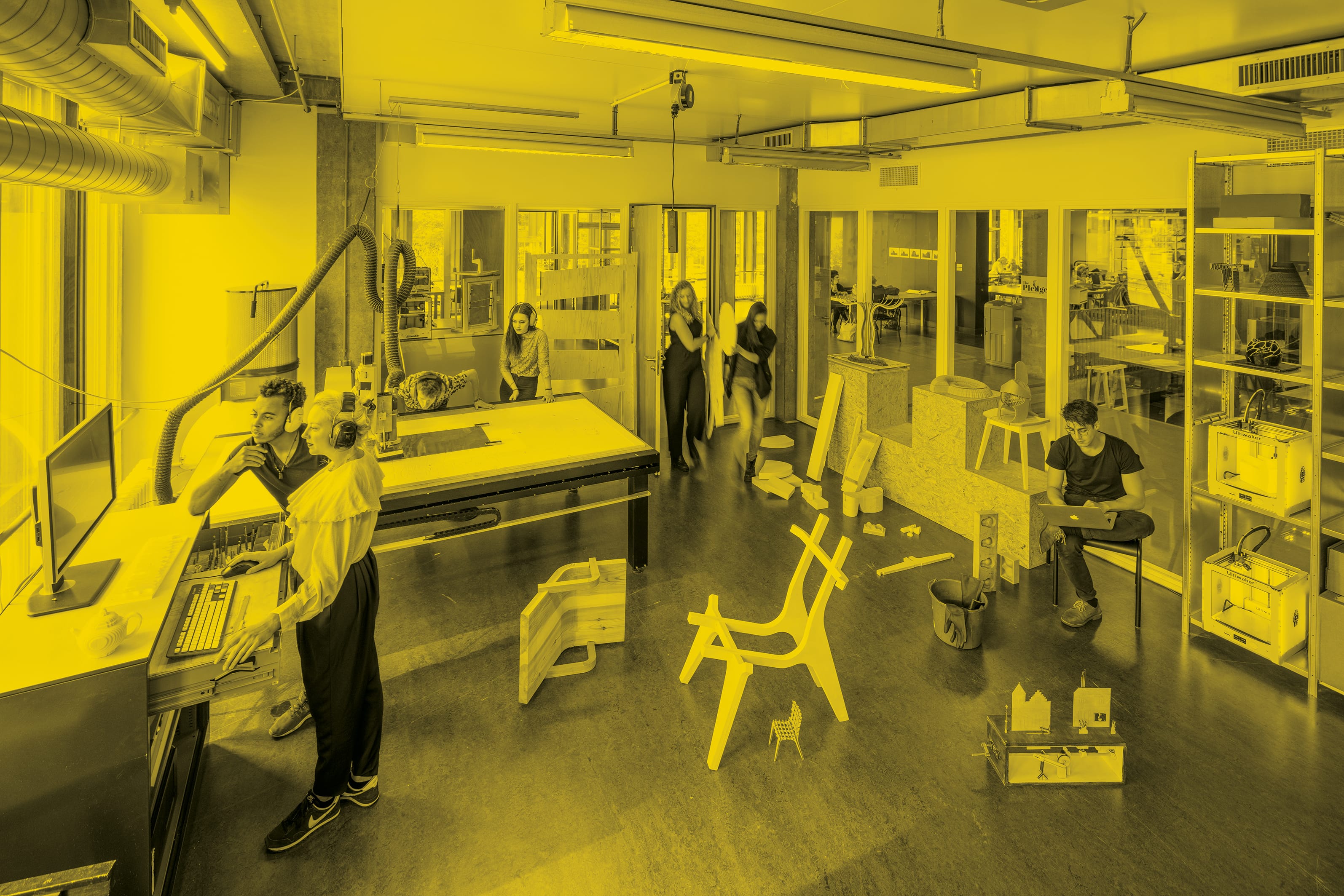
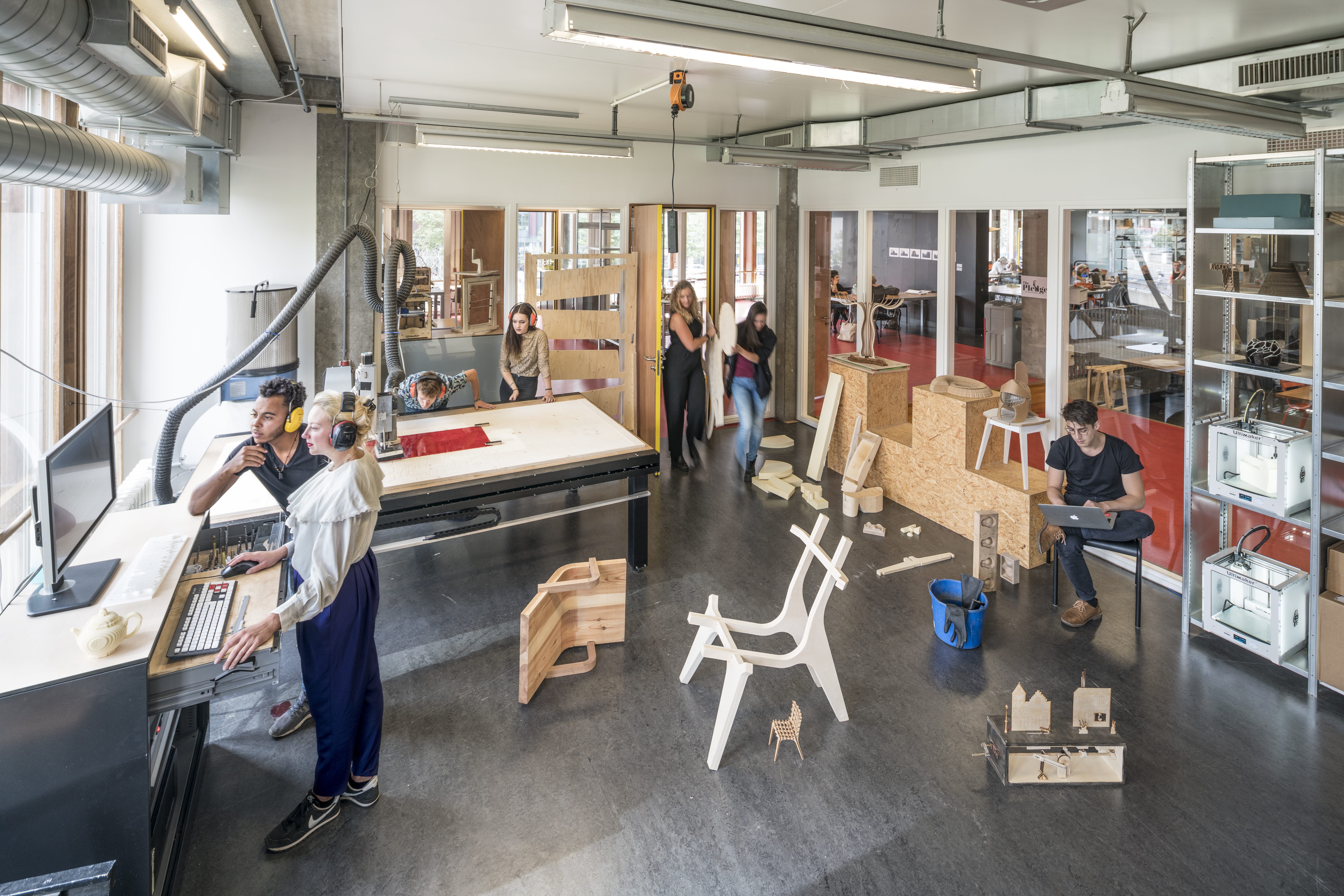
The Material Station, Photo: Ossip van Duivenbode
The Stations

“My dream is that our students will contribute to a more sustainable fashion and textile industry in the future.”
John Coenen, Coordinator, Fabric Station
The Stations are more than just workshops; they are the primary arteries running through the WdKA. Open to all of our educational pathways and programmes, they promote research through making, old and new technologies and crafts, and critical approaches to media. The Stations are places where students and staff can experiment and explore the viability of their ideas through making with the support of technical experts. The chart shows the potential use of each Station along with related methods taught and issues addressed.
Evaluation & Improvements
Competencies and Profiles Informed by the Professional Fields: The 2017 EQ-Arts Audit noted: “The Evaluation Team has heard ample evidence that the school found a commendable way to include internal and external key stakeholders in the process of developing the new curriculum.” While the 2013 NVAO Accreditation reviewed Standard 1 as good and gave no recommendations for improvement, the WdKA sees its professional network as something to be continually maintained to stay sharp with changing demands. Having an array of partners with which we continually work, ensures that the links between the professional fields of art and design remain tight. Next to this, we have an extensive list of partners with whom we work. Equally important is the professional experience of our staff who have their own practices outside of the academy. We also look at the achievements of our alumni in terms of understanding whether we have equipped graduates with the skills and knowledge required. The Practices, in dialogue with partners/stakeholders, and with the input and guidance of the Research Professors, have sharpened their profiles and updated their Position Papers.19 Partnerships were especially integral to shaping the Autonomous Practices profile as most are actively engaged in the Autonomous Fabric research project.20 Also, some of the Minors were reviewed and renewed on the basis of student feedback, teacher evaluations and the Curriculum Committee, in collaboration with external partners. For example, the Minor New Earth within the Social Practices collaborated with experts from Afrikaanderwijk Coöperatie.
Based on feedback, the Minors in the Social Practices have been updated: Sustainability was developed into New Earth21, and Gamification was developed into Powerplay. In September 2019 the Minors in the Commercial Practices will be updated: Service Design will become Next Design Lab. Currently, the Autonomous Practices are in the process of reviewing related Minors. The outcomes will be published in 2020.
Next to this, all Curriculum Descriptions are evaluated annually on the basis of student feedback, teacher evaluations and the Curriculum Committee. The embedding of competencies and articulation of learning outcomes are core focuses during this reviewing and improvement process. In 2018 the Curriculum Committee initiated focus groups on themes such as media focus, research methodologies, entrepreneurship and intercultural competencies to ensure profile and competency alignment across all Curriculum Descriptions.
Student feedback revealed that they needed clarification on the Practices; in response, updated descriptions were placed on MyWdKA. In academic year 2018-2019, all the Practices have continued to work on further identifying each Practice’s relation to the field and towards each other:
These are being worked on by the Practice teams in the projects and activities of academic year 2019-2020.
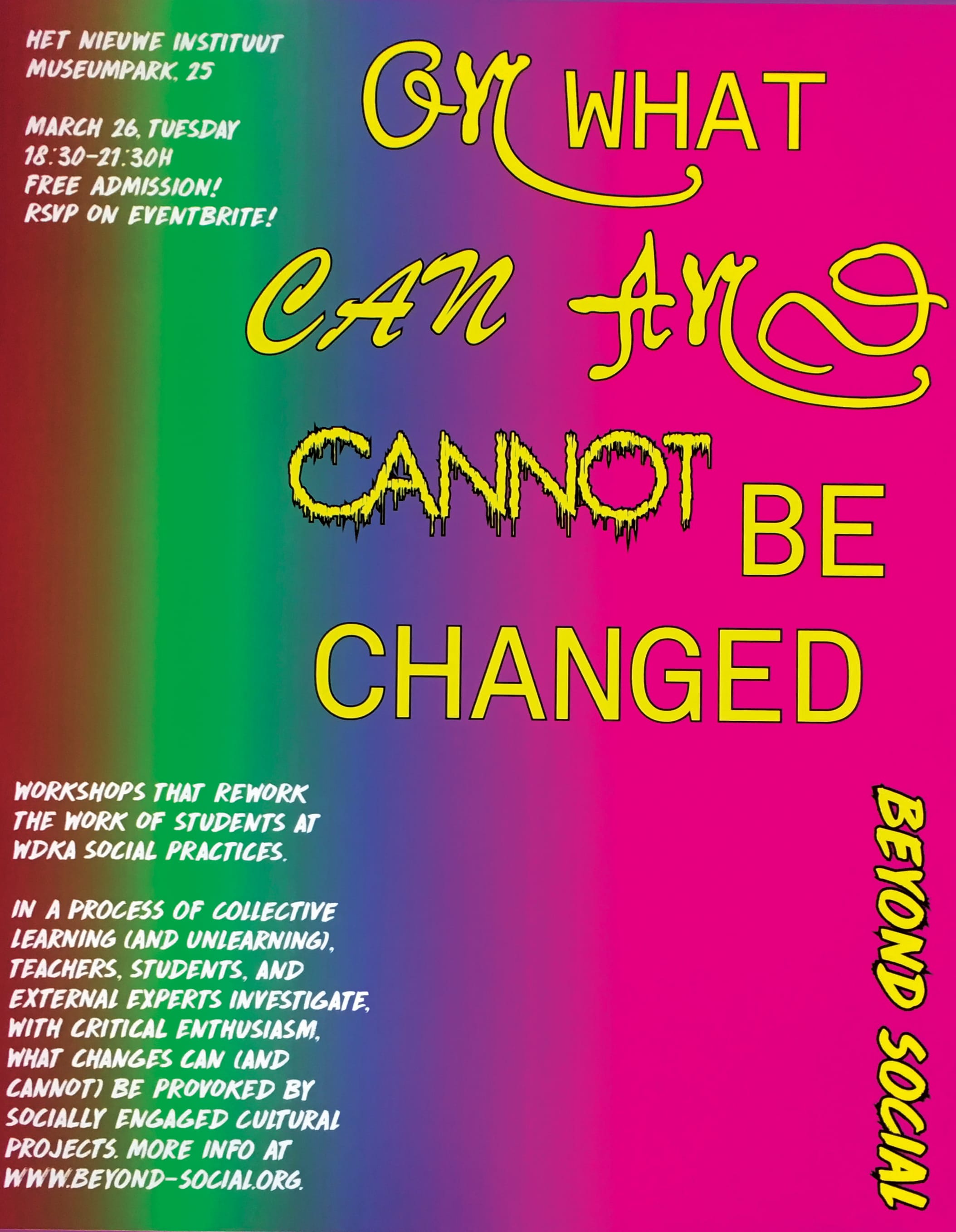
Standard 2: Teaching & Learning Environment
While creating pioneers is our aim, making that a reality requires hard work, coordination and strategic planning on many different levels in our teaching and learning environment. Competencies for Art and Design are embedded through various modules in the curriculum.22 They are supported through the knowledge and expertise of staff and enabled by the various facilities available. Finally, they are kept current in their articulation through our engagement with internal and external stakeholders.
The Structure of the Curriculum: The competencies have been calibrated and translated into learning outcomes, knowledge, skills and attitudes within modules.23 Each functions as a building block for competency acquisition. The chart below illustrates how modules add up and EC’s are weighted as they are distributed over the course of four years. These modules, covering both theory and practice, lead up to and include graduation.
| Fine Art and Design | |||
|---|---|---|---|
| Course/Project | EC | Assessment method | Term description |
| Term 1.1 | |||
| Major | 18 | Oral and visual presentation based on assignments | Start Major, focus on gaining disciplinary knowledge and skills, learn to think conceptually in a professional context. |
| Major Theory | 6 | Paper based on assignment | Theoretical framework of discipline in relation to the project, and start with reflection on subject matter. |
| Plusweek 1.1 | 4 | Evaluation of Plus plan | Additional learning activities in a self-directed programme consisting of self-initiated learning activities and electives. |
| Term 1.2 | |||
| Practice P1 | 9 | Reflection on workshops | Introduction to the attitudes, content and methodologies of the Autonomous, Social and Commercial Practices. |
| Practice Theory | 3 | Paper based on assignment | Focus on contemporary theoretical frameworks in conjunction with the Practices. |
| Term 1.3 | |||
| Major | 9 | Oral and visual presentation based on assignments | Second Major Project, acquisition of the necessary knowledge and skills to enter the second year. |
| Major Theory | 3 | Paper based on assignment | Focus on the disciplinary theoretical framework in relation to the project, and start with reflection on subject matter. |
| Plusweek 1.3 | 2 | Evaluation of Plus plan | Additional learning activities in a self-directed programme consisting of self-initiated learning activities and electives. |
| Terms 1.1, 1.2, 1.3 / year | |||
| Study Career Coaching | 2 | Participation and deliverables | Development of professional competencies: independently research, determine and justify study choices. |
| Electives | 4 | Oral and visual presentation based on assignments | Electives are short projects in which students are introduced to the content and methodology of the Practices, specific skills in the Stations or short practice-based projects. |
| Term 2.1 | |||
| Major | 18 | Oral and visual presentation based on assignments | Third Major Project, focus on gaining necessary professional knowledge and skills, and working conceptually in a professional context. |
| Major Theory | 6 | Paper based on assignment | Theoretical framework of discipline in relation to the project, start of developing personal perspective on the subject matter. |
| Plusweeks 2.1 | 4 | Evaluation of Plus plan | Additional learning activities in a self-directed programme consisting of self-initiated learning activities and electives. |
| Term 2.2 | |||
| Major | 8 | Oral and visual presentation based on assignments | Fourth Major Project introduces relevant contemporary disciplinary aspects, and learns to apply knowledge and skills in complex contexts. |
| Major Theory | 3 | Paper based on assignment | Theoretical framework of discipline in relation to the project, continuation of developing personal perspective on the subject matter. |
| Competency Assessment 2 | 1 | Portfolio; Visual and oral presentation; Interview | First overall reflection on and assessment of the competence level of each student as acquired after 4 terms of the bachelor's programme. |
| Term 2.3 | |||
| Practice P2 | 9 | Oral and visual presentation based on assignments | Preparation of Practice year 3, investigation of engagement & identity as an artist or designer by studying in two different Practices. |
| Practice Theory | 3 | Paper based on assignment | Theory programme focuses on contemporary theoretical frameworks in conjunction with the Practices. |
| Plusweek 2.3 | 2 | Evaluation of Plus plan | Additional learning activities in a self-directed programme consisting of self-initiated learning activities and electives. |
| Terms 2.1, 2.2, 2.3 / year | |||
| Study Career Coaching | 2 | Participation and deliverables | Focus on academic progress, independent working attitude, ambitions, motivation, personal and professional qualities. |
| Electives | 4 | Oral and visual presentation based on assignments | Electives are short projects in which students are introduced to the content and methodology of the Practices, specific skills in the Stations or short practice-based projects. |
| Term 3.1 | |||
| Major | 12 | Standalone visual presentation based on assignments | Fifth Major Project, parallel to the Practice project, focus on preparation for professional context. Students apply knowledge and skills in complex disciplinary contexts; students converge to a specific position in the disciplinary field |
| Practice | 9 | Standalone visual presentation based on assignments | Specialisation: choice of one within the Practices to deepen Art & Design profile, project in conjunction with stakeholder, partner or real world context. |
| Practice Theory | 3 | Paper based on lecture series and assignment | Theory programme focuses on contemporary theoretical frameworks in conjunction with the chosen Practices. |
| Competency Assessment 3 | 1 | Portfolio; Visual and oral presentation; Interview | Second overall reflection on and assessment of the competence level of each student as acquired after 7 terms of the bachelor’s programme. |
| Plusweek 3.1 | 4 | Evaluation of Plus plan | Additional learning activities in a self-directed programme consisting of self-initiated learning activities and electives. |
| Term 3.2/3.3 | |||
| Major([De]Fine Art) | 28 | Oral and visual presentation based on projects | Fine Art: participating in group studio, working on self-directed projects, or internship. |
| Presentation ([De]Fine Art) | 1 | Standalone visual presentation based on assignments | |
| Internship mandatory for design and optional for Fine Art |
28 | Overall assessment by the internship tutor at the WdKA, based on the studio evaluation, a studio visit, student presentations at 3 group sessions at the academy and the internship report. | Work in professional context, learn the scope of a design or art practice, apply knowledge and skills, and investigate chosen position. |
| Internship report | 1 | Written internship report | |
| Terms 3.1, 3.2, 3.3 / year | |||
| Study Career Coaching | 2 | Participation and deliverables, most notably the Creative Business Assignment during internship. | Increased emphasis on orientation towards future profession and development of a professional attitude. |
| Term 4.1 | |||
| Minor Practice Project | 13 | Standalone and public visual presentation based on assignments | Minor within one of the themes of Autonomous, Social or Commercial Practices; problematising and strategising in complex professional situations and societal and economic challenges. |
| Minor Research Project | 13 | Research report document | Research Paper in relation to the theme of the Minor, related to the development of the work and methodology. |
| Plusweeks 4.1 | 4 | Evaluation of Plus plan | Definition of research question for graduation project. |
| Term 4.2/4.3 | |||
| Competency Assessment 4 | 14 | Portfolio; Visual and oral presentation; Interview | The third and qualifying Competency Assessment |
| Research Project | 7 | Research report document | Documentation of the research, theoretical findings and connection to physical practice-based research. |
| Practice Project | 7 | Standalone and public visual presentation of exam work | Graduation with a final project as an Artist, Designer or Educator within one of the three Practices. |
| Terms 4.1, 4.2, 4.3 / year | |||
| Study Career Coaching | 2 | Participation and deliverables | Professional competencies: orientation to future profession and professional attitude. |
| Total Number of Credits | |||
| 240 |

"My advice to art academy aspirants: dare to step out of the traditional limits of your major. Don’t think that you can’t do or try something because you are not in the right department. Experiment and try out new things as much as you can."
Maria Mombers, second-year student of the Illustration Major who is testing both Autonomous Practices and Social Practices to find the pathway that best suits her.
The Stations & the Curriculum: The Stations and related instructors provide education in skills and promote research through making; they work in synthesis with the modules and tutors, and also promote self-directed study. Providing a rich array of facilities, from the digital to traditional craft, they are integral to the learning process and curriculum.24

"The school is here to support you in whatever you would like to do, instead of obliging or putting limitations on you. I would describe the WdKA vibe as spacious - in all forms, there is always enough room to work in and enough room for interpretation, resource-full - because there are so many facilities and knowledge, and free - there is a lot of space for individual development."
Tim van der Plas, first-year student in the Fashion Design Major interested in Autonomous Practices
Research In Context
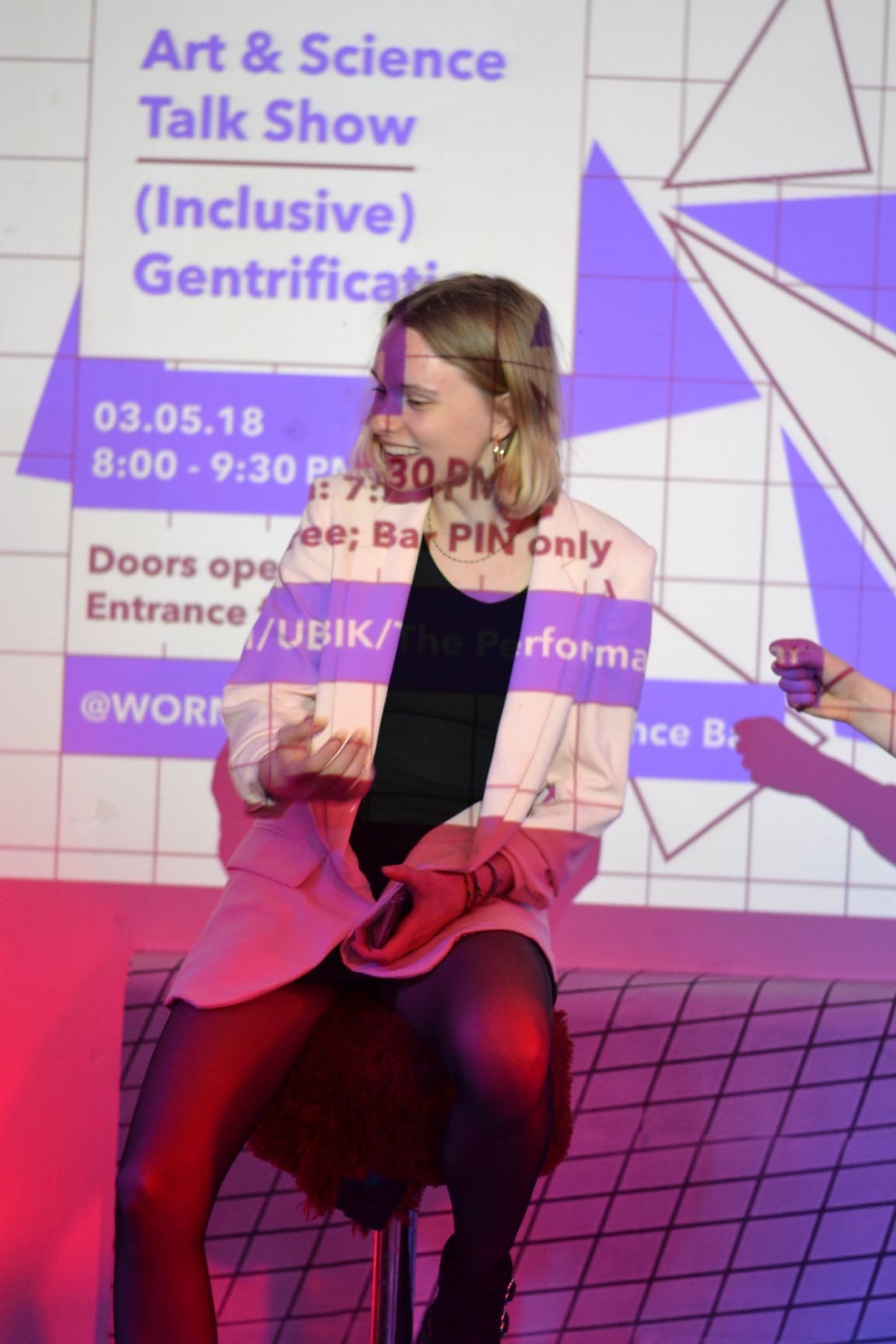
"Lately, I have been trying to redefine research to fit my own fascinations and use my knowledge in a different way. I am passionate about feminism and art activism. This is the basis I want to use to further explore as a designer."
Gabija Bubnyte, third-year student, Double Degree - Graphic Design Major & Erasmus University College, International Relations and Politics
Research in the Curriculum: Research and its accompanying methodologies are embedded in different modules, most predominately in the Minors and Graduation where they are identifiable as credit-bearing. Within each module, the educational teams work together in determining how research is defined in relation to the content of Practices and Majors. Research Tutors ensure methodologies and skills are covered in relation to learning outcomes.
Research in the Stations: Research through making is part of the profiling of all Stations. Users are introduced to, or increase their understanding of, the terminology of research through making (i.e. iterative processes, prototyping, versioning, etc.). Rather than abstract methodologies, students acquire grounded approaches to research embedded in specific practices. Next to this, the Research Station provides support on how to navigate and cite source materials and formulate research questions, and on processes of description, evidentiary thinking, analysis, synthesis and writing. The Research Station provides a working space for Research Professors and Senior Research Lecturers, houses the library, hosts group discussions for staff and students and presents artistic products based on their research value. This role as a meeting place and forum for knowledge exchange is a crucial dimension of the Research Station.
Externally Funded Research Projects: In collaboration with, amongst others, its RASL partners, the WdKA has been successful in acquiring external research funding from the NWO (Comenius and Smart Culture granting schemes) and KIEM.25 An example is GAMPSISS, in which third-year Honours art and design students work on the Hybrid Lab project under the guidance of Research Professors, professors from the Erasmus University and researchers at TU Delft on the central research question.26 As a research project, GAMPSISS explores whether the promotion of an active listening culture would positively affect current transitions within society and lead towards a smarter, more inclusive and sustainable future. For these purposes, it uses gamification as the central methodology for creating ‘gameful performances’.
Another example of a research trajectory is the Autonomous Fabric, funded by KIEM and Pictoright, in which first-, second- and third-year art & design students interview and map the large array of autonomous initiatives in Rotterdam.27 Their contributions are made public on a digital platform, through exhibitions in the Research Station and as part of the Autonomous Fabric events.28
Currently, within the RASL context and with the support of a Comenius Leadership Fellow grant, a transdisciplinary Minor is being developed by a team of teachers from the WdKA, Erasmus University and Codarts under the guidance of the Research Professors. This Minor, Reimagining Tomorrow through Arts & Sciences is one of the contemporary research pathways that further investigates the hybridisation of art and design. 29
Externally Juried Research Awards: To put a stronger emphasis on research and acknowledge our student achievements, the WdKA initiated the Bachelor and Master Research Awards. Each year a selection of graduation projects and research documents are reviewed by an external panel, and three bachelor’s students are awarded Research Prizes (1st, 2nd, 3rd). These result in a funding award, and projects are also selected for a Hybrid Publication.
Teaching Staff: Notably, our curriculum, research and Stations are informed by the professional experience of our tutors. All, whether working on a fixed or temporary contract, are highly qualified and bring their professional experience and network into the learning environment. Many have had their own work validated through grants awarded by the Centrum Beeldende Kunst (CBK), which supports artists in Rotterdam, and the Mondriaan Foundation and the Creative Industry Funds, the national funding bodies for art and design. This means that rather than imparting knowledge in abstraction, competencies are concretised through the professional realities our art and design educators encounter outside of an academic setting. Through annual staff reviews consisting of evaluation, planning and assessment with management, different ways are sought to integrate their professional perspectives into daily teaching.30
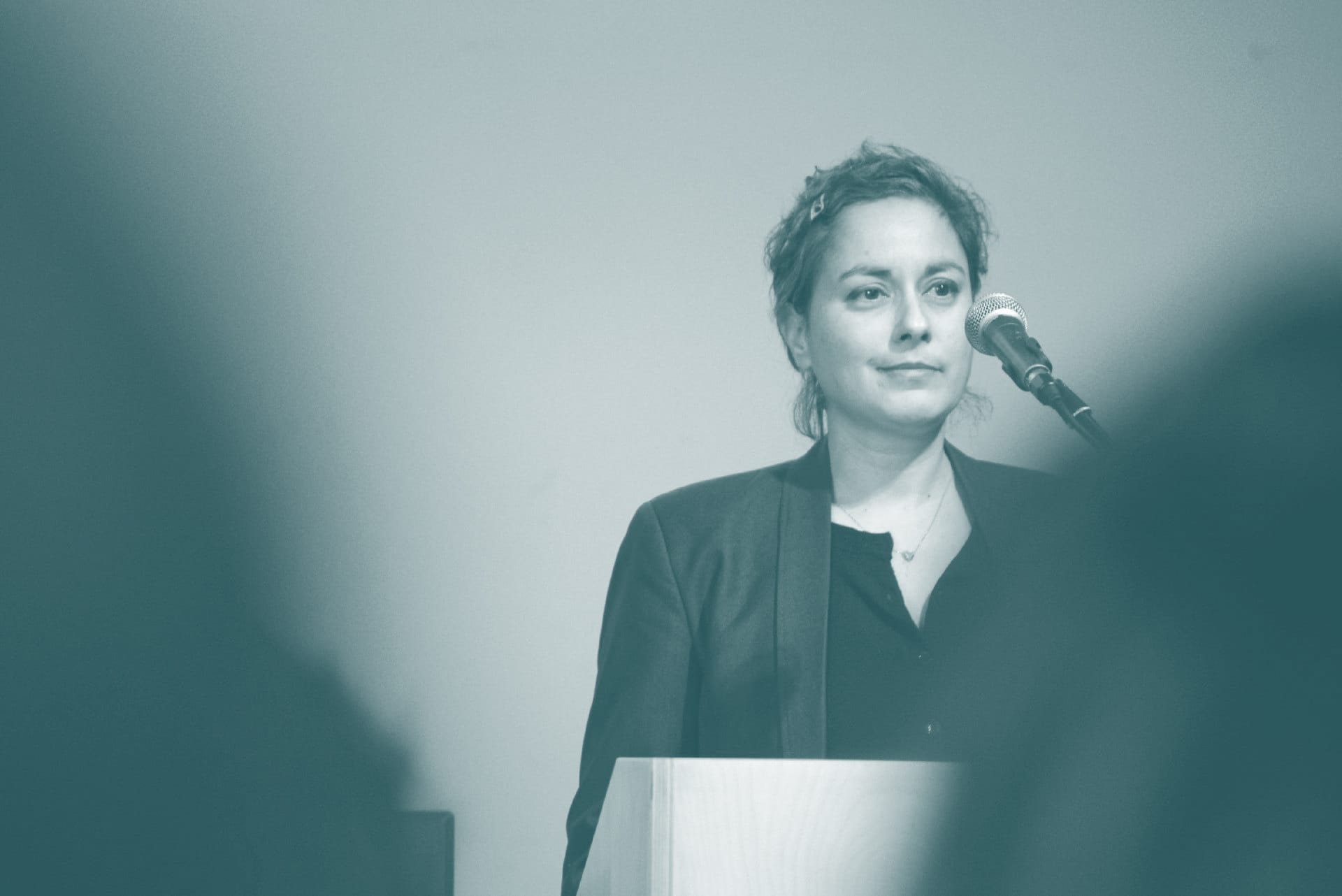
"I am not teaching anyone what to think (I hope) but rather making them feel more at home in how they reflect, in referring to various ideas or visions. And I assume that it will in one way or another affect and stimulate their mind and creative process."
Esma Moukhtar, tutor, (De)Fine Art Major and Critical Studies in Autonomous Practices
Teaching & the Education Station
Teaching at the WdKA involves being part of a learning community. Tutors, instructors, students and facility staff are all part of this community and its iterative process of learning. The Education Station is central to shaping our learning environment. It initiates and facilitates the professional development of our education.
To ensure cohesion and maintain a consistent approach to competency acquisition, it is equally important that our tutors are also well trained to teach. To know is one thing, but knowledge transfer and exchange requires another skillset. This is especially challenging in project- and competency-oriented teaching that moves away from more traditional pedagogical approaches. For this reason, the Education Station has described a set of approaches and established routes of support for teaching staff. The tutor’s role within project- and competency-oriented teaching means that:
In this pedagogical model, students are active participants in the educational process; rather than being directed by the tutor, the students learn to direct themselves. Tutors contribute their own knowledge and specialisation to a project and supervise students from the perspective of this knowledge.
To support teaching staff in these efforts, the WdKA has resources that are available through the Education Station. These are:
Next to this, there are Educational Days that touch upon a variety of themes ranging from research, assessments, feedback/feedforward and highlighting the potentials of the Stations. Staff have also been supported in pursuing master’s and doctoral degrees, and Research Lecturers are allocated research time.31 In 2019 three tutors have completed their PhD, two at Goldsmith and one at KU Leuven, while at least six tutors are preparing for a PhD and two more are waiting on the successful application of a NWA research grant to start on a PhD trajectory.
Student Guidance & Support:
WdKA Study Career Coaching: During their education, students encounter new challenges connected either to the process of studying or the development of their own professional competencies and individual preferences. A designated Study Career Coach (SCC) advises students in navigating through these processes. With support and learning trajectory supervision, they guide students through these challenges with increasing independence.
PALs: Another support figure students can turn to are the PALs (Peer Assisted Learning assistants). They are more experienced senior students working within the Stations. As instructors, they can offer practical help in the Stations, but they also operate as peer coaches due to their own experience of studying at the WdKA.
RUAS Support: If students need confidential advice or support on personal issues, they have access to professional student counsellors. There is also support for students with learning disabilities. The International Office helps foreign students navigate the legal and civic formalities of living in the Netherlands.
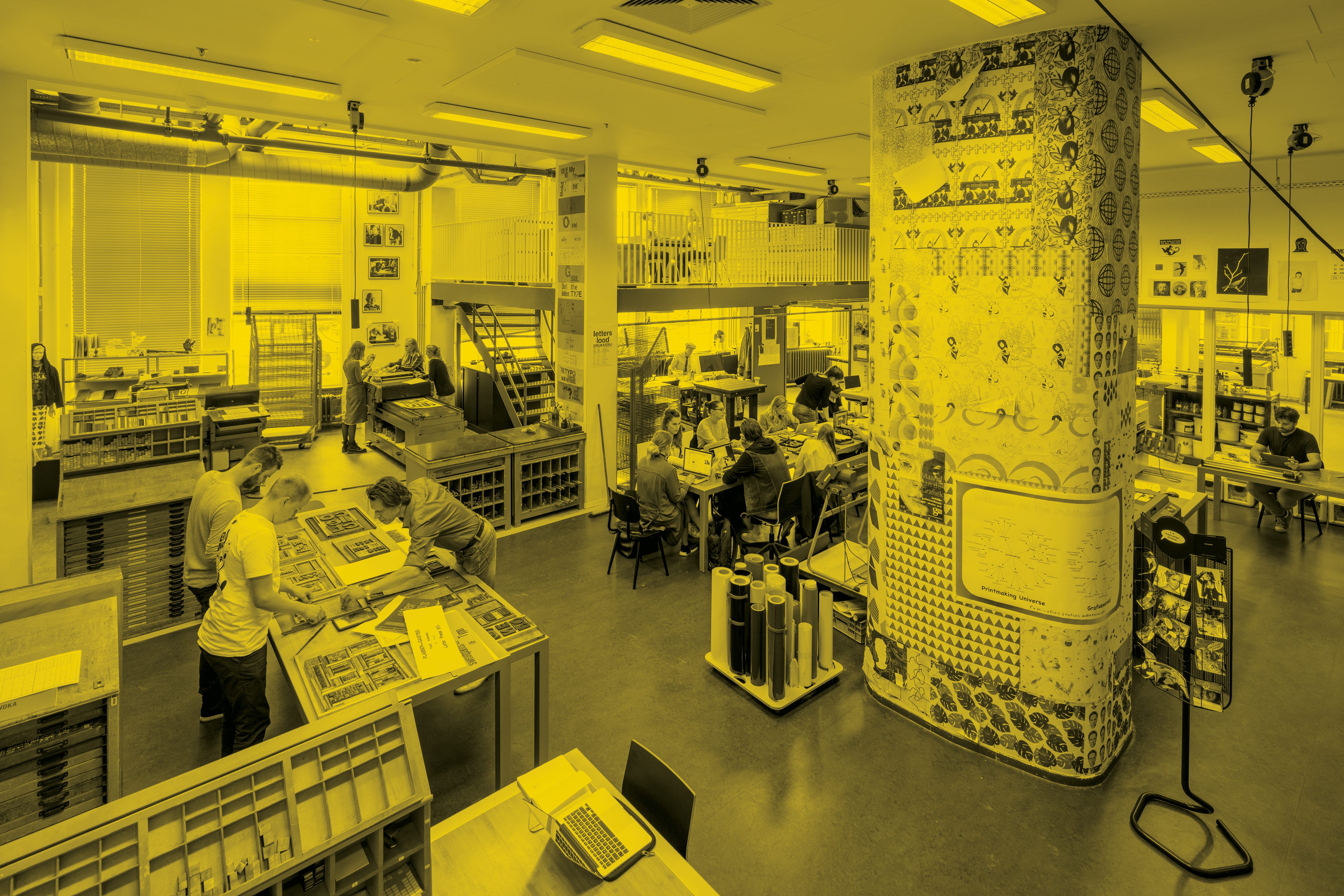
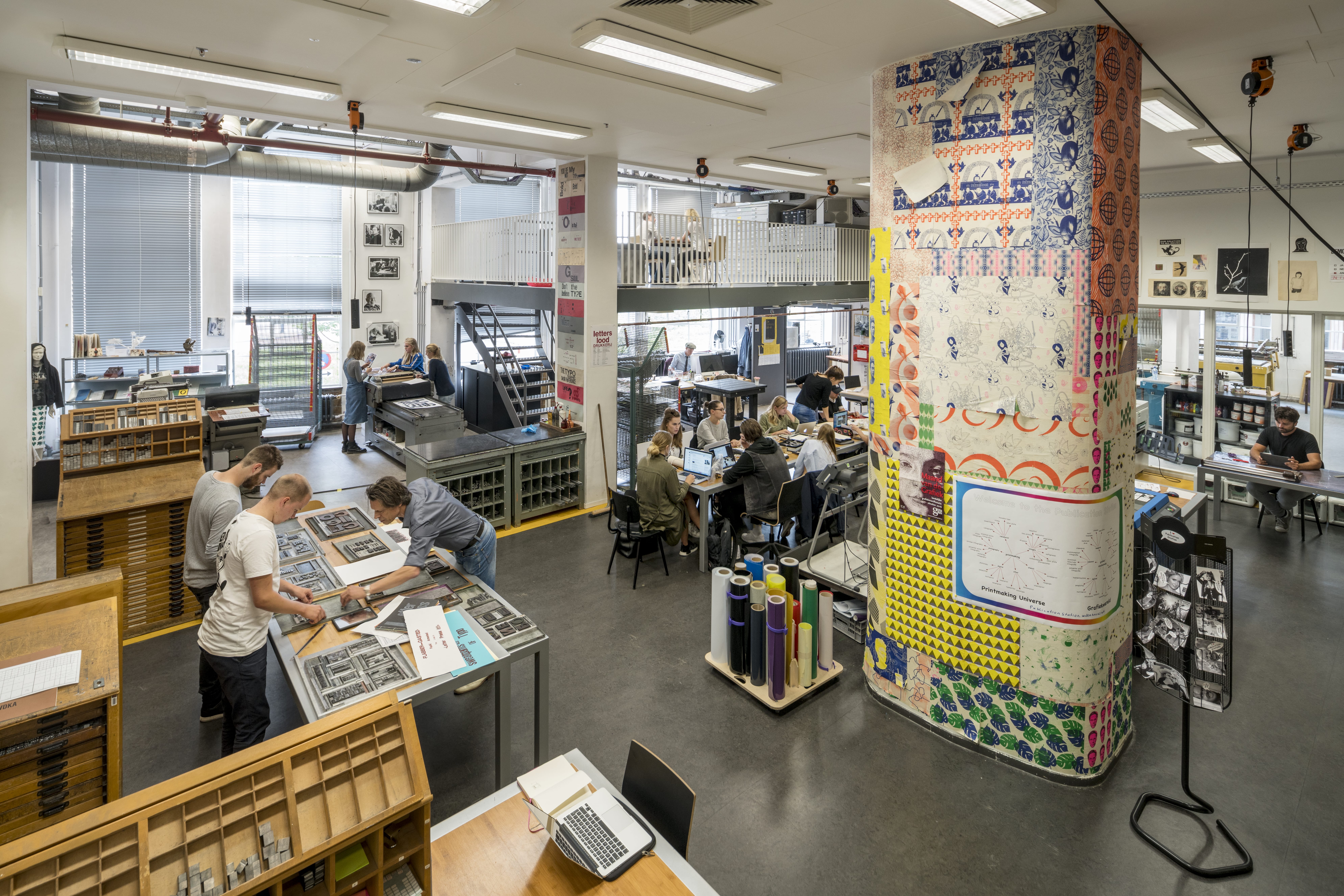
The Publication Station. Photo: Ossip van Duivenbode
Systems of checks & balances:
The Curriculum Committee gives advice to management, course leaders and teachers regarding the development and improvement of the curriculum of the WdKA. It focuses on three specific areas: the content of the curriculum; the design, form and didactics of the curriculum; and competency coverage.
The Examination Board (Examencommissie) determines if and to what extent students fulfil the criteria of the Course and Examination Regulations (OER) with regard to the skills, knowledge and competencies required to obtain a diploma. The Examination Board is responsible for monitoring the quality of examinations and assessment procedures, and for sanctioning cases of fraud and plagiarism.
The Assessment Committee (Toetscommissie) is not compulsory by law or university policy, and operates under the mandate of the Examination Board. The primary focus of the Assessment Committee is to assess the quality of all forms of assessment within the curriculum and advise on aspects of improvement.32 33
The Programme Advisory Board (Opleidingscommissie) offers advice on various matters related to the education programmes, including the Course and Examination Regulations and measures to improve the quality of the programmes. The Board discusses the results of evaluations and suggestions for improvement, and thus plays an important role in quality improvement measures for education programmes as well as the institute’s quality control system. The Board’s tasks, responsibilities and jurisdiction are described in the WHW Act (‘Wet op het hoger onderwijs en wetenschappelijk onderzoek’, the Dutch law on higher education and scientific research) and in the Rotterdam University of Applied Sciences’ Regulation on Programme Advisory Boards.
The Institute Works Council (Instituutsmedezeggenschapsraad or IMR) is a statutory advisory body which represents the views of students and staff members in consultations with management. The rights and obligations of the Institute Works Council are defined by statutory law. The Institute Works Council has a right of assent in matters regarding the budget, the Course and Examination Regulations, and the professionalisation plan. The Institute Works Council has a right to be informed in organisational matters and may provide advice upon request, as well as proactively. The Institute Works Council is also required to monitor issues related to discrimination and harassment.
To ensure that the Stations remain up-to-date in terms of its facilities, the WdKA is a member of ETHO, the European Technical Heads Organisation. ETHO is a network for leading European Art and Design Academies, aimed at those individuals responsible for developing technical areas for teaching, learning and research. The previous ETHO workshops and meetings were hosted by the Royal Academy of Art in 2016; KABK and WdKA in 2017 (The Hague, Rotterdam - the Netherlands); Glasgow School of Art in 2018; The Bergen Academy of Art and Design, Norway in 2018; and Aalto Arts University, Helsinki, Finland in 2019.
Evaluation & Improvements
The renewed curriculum was accredited in 2013 by the NVAO. In fall 2016, a bottom-up process (RASP, Restructuring All Study Periods) was initiated by Course Leaders, Practice Coordinators and core tutors based upon the experiences of students, teachers, external advisors and RUAS Audits with the curriculum from 2013 - 2016. Six themes of improvement were identified:
Phase 1: The goal of RASP is to introduce a study programme structure with less activities taking place at the same time, thus providing students with more opportunities for further exploration (deepening) within the projects. As a result, the student’s attention will be more focused and less divided. The PLUS + programme encourages students to assume greater control of their own study agenda while also helping to reduce study delays. For staff members, these changes will reduce moments of high pressure within the academic year planning while also providing moments for team reflection and planning (the Drive and Development weeks).34
Stimulate Self-directed Study: The main goal of the PLUS + programme is to allow students to formulate and further develop their own interests, and to make choices within the WdKA curriculum. Within this process, students learn to make decisions based upon reflection and regarding their own (artistic) development. The PLUS + programme also provides opportunities and supervision for students who have a study delay and/or must re-sit specific programme components. Furthermore, the PLUS + programme provides students with the opportunity to combine and enrich their own self-defined efforts through focused and inspiring elective modules.
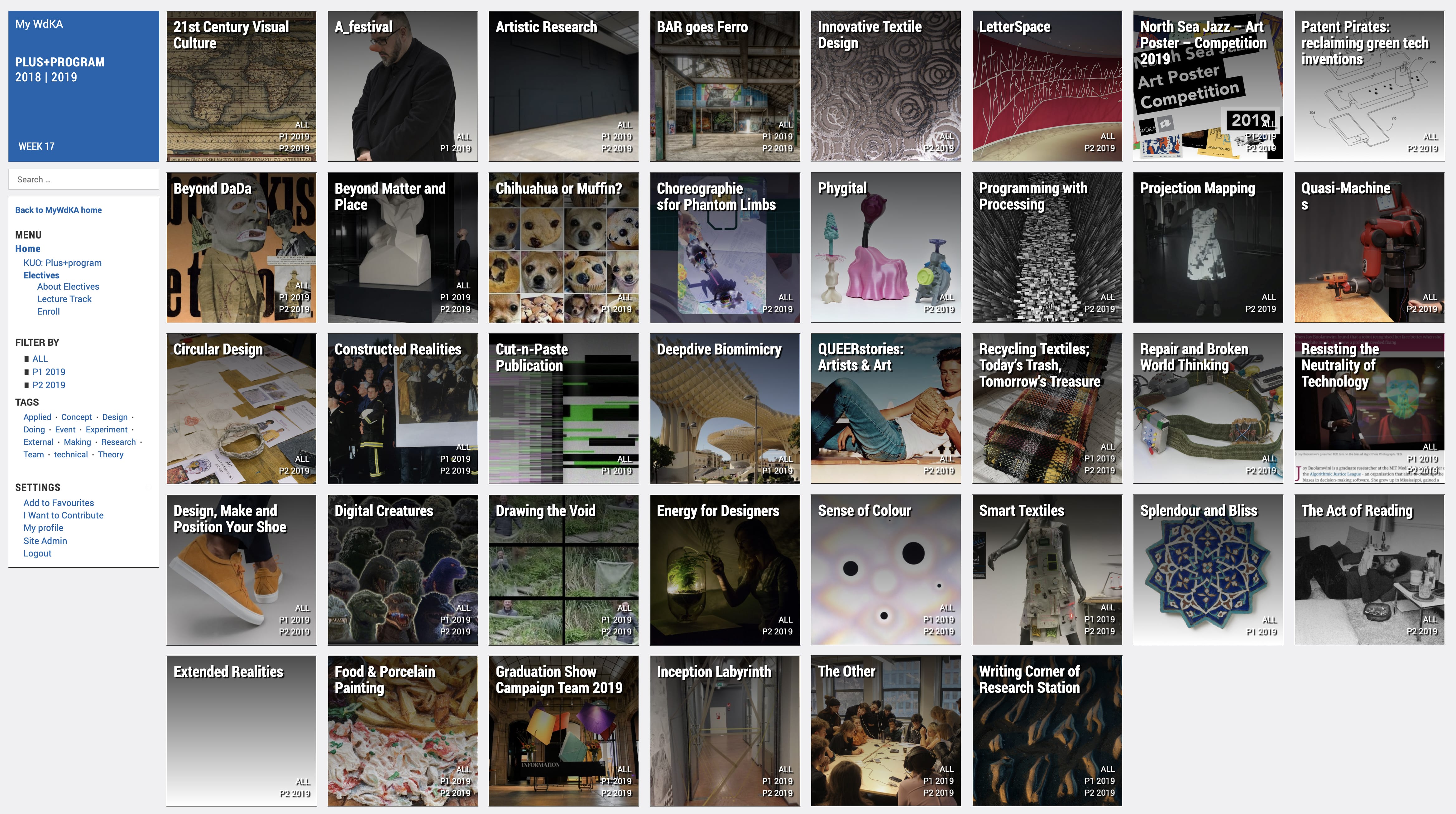

Electives Plusweeks January 2019
Introduction of the Practices through Practice 1: The goal of this term is to introduce students to the three graduation profiles (Practices). Students familiarise themselves with the approach, context, professional roles and methodologies associated with the three graduation profiles. This introduction focuses on exploring intrinsic motivation in the context of the themes and practical examples provided by the Practices. In this way, students can begin developing their personal approach to design or their artistic position while looking ahead to the related study choices in later phases of the study programme.
Phase 2: The introduction of RASP in 2017-2018 in the first and second years lead to the following improvements:
There is room for improvement in the following:
In academic year 2018-2019, RASP was introduced to the third and fourth years and lead to:
National Student Survey feedback showed dissatisfaction with scheduling. The reservation and booking system needs to be optimised in terms of use by staff and clear guidelines need to be given for schedule changes happening in a timely manner.
Based on student feedback from Quality Assurance, students felt Practices and Majors could be better aligned. This is partially a problem with communication. There will be two working sessions with staff in October 2019 where this relationship will be discussed and Practices will be further developed.

"My goal is to provide a space for students where failure can sometimes be an option and a place where they feel free to take risks."
Mike Pelletier, instructor, Interaction Station
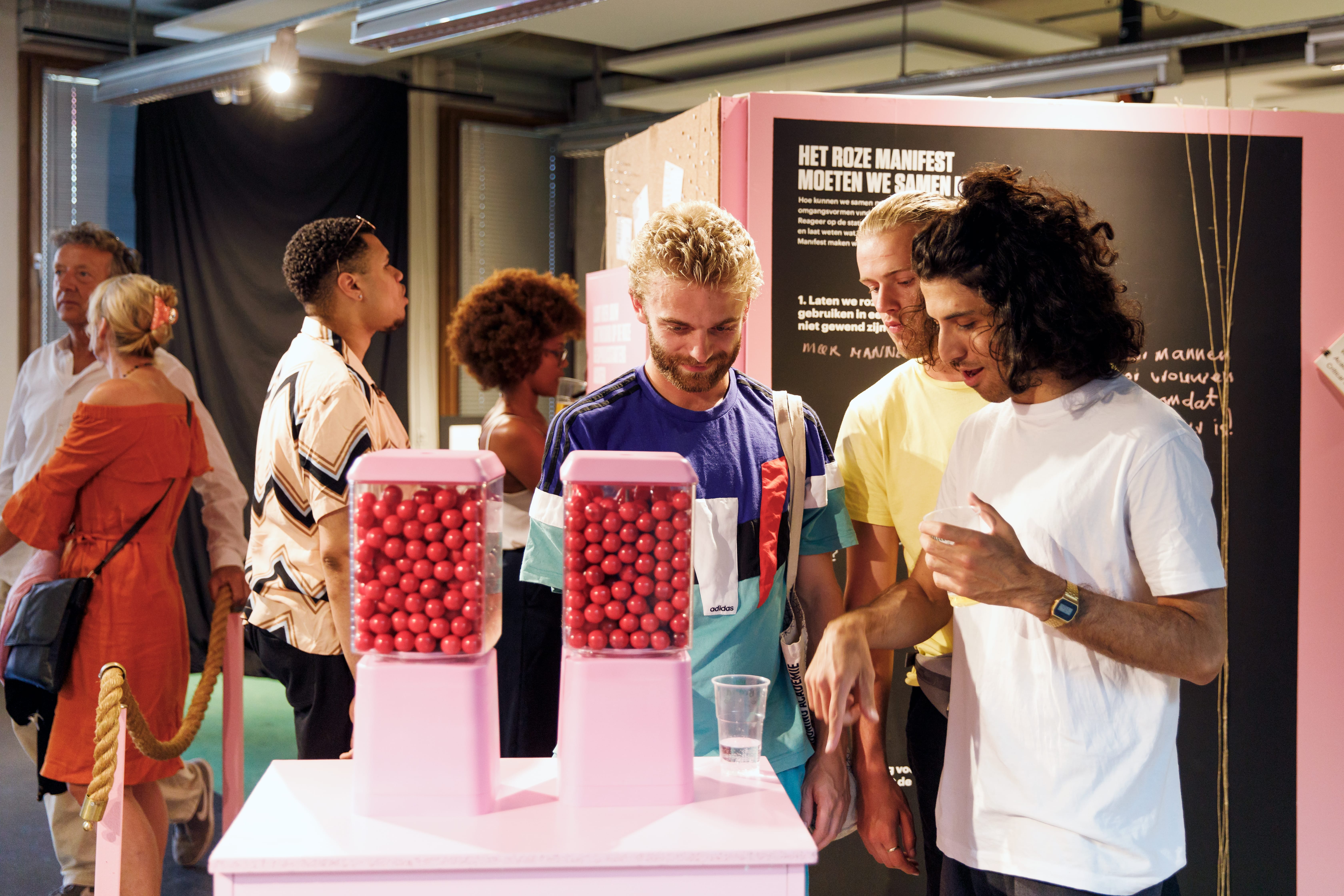

The Pink Manifesto, Lieke Steen (Autonomous Practices/Graphic Design)
Standard 3: assessments
Assessments are never an easy moment for students, but we are diligent about working towards making the process transparent, the criteria explicit and feedback insightful for students. Assessments for the Fine Art and Design programmes are integrated into the educational programmes and are aimed at measuring acquired competencies and ensuring the intended level of professional development throughout the Majors, Minors and Practices.
Competency Assessments (CA) are the backbone of the WdKA, gauging the qualitative progress and development of the student’s learning processes. Students are assessed against the full set of final qualifying competencies, which have been built on national and international frameworks for Higher Education in Art and Design. For each of the Competency Assessments, specific levels have been defined within the seven-competency set. Levels differ in the amount of guidance and instruction, the developing self-organisation, and the growing complexity of tasks.35
All Fine Art and Design programmes have been designed to allow the student to develop from CA1 (admission), usually with no prior formal training, to CA4 (fully competent at the bachelor’s level). The study matrix maps how the study components address the specific competencies.36 This does not exclude the involvement of other competencies (they tend to develop integrally), but shows the emphasis in the design of the specific component. For CA1 (admission), candidates spend a full day in one of our studios, working on assignments, discussing their portfolios, and being interviewed by two assessors. The documented results are used to assess the candidate on their ability to study in one of our programmes and to formulate concise advice on their future developments.
Structure & methods of Competency Assessments CA2, CA3 & CA4
Before the actual assessment meeting, students prepare a portfolio with reflections on learning processes and experiences, using key works, projects they have participated in, theory coursework, research components, etc. In their portfolio they critically discuss their progress regarding all seven competencies. In CA2 students employ the “ Assignment, Goal, Action, Result and Reflection” method referred to as ODARR in Dutch (Opdracht, Doel, Actie, Resultaat en Reflectie).
In the CA3 phase students have more freedom to organise the portfolio according to individual developments and affinities, and make extensive use of non-verbal presentation forms. The final CA4 portfolio has to cover all seven competencies on the level that qualifies for the bachelor’s diploma in whatever form the student chooses. Students passing this assessment eventually graduate upon successful completion of their Graduation Projects.
After uploading the complete portfolio to the Osiris system, the student is invited to meet with two specially trained assessors who have studied the portfolio in advance. Student can bring along an observer (e.g., a fellow student) to any of the assessments.37 In CA2 the assessors are tutors connected to the student’s Major, and in CA3 and CA4 they form mixed teams of Major and Practice tutors. An assessor cannot be a student’s tutor at the moment of assessment.
After a presentation by the student, in which they show additional material, clarify their position as an artist or designer, or show a preview of graduation projects or future professional activities, an interview follows, based on the portfolio and presentation.
Assessors formulate their findings and feedback on the feedback form and mark every competency as a pass (demonstrated) or fail (not demonstrated). Assessors must reach a consensus on the results and (re)commendations. In CA2 and CA3, geared towards development, the student can fail 2 out of 7 competencies and still pass the overall assessment. The assessments are partly formative: they inform students on the development of their competencies; and partly summative: students are awarded credits and qualify for further study or graduation.
Apart from the Theory coursework, the Competency Assessment portfolios are the only student works that are collected and archived from the students of year 1 through 3.
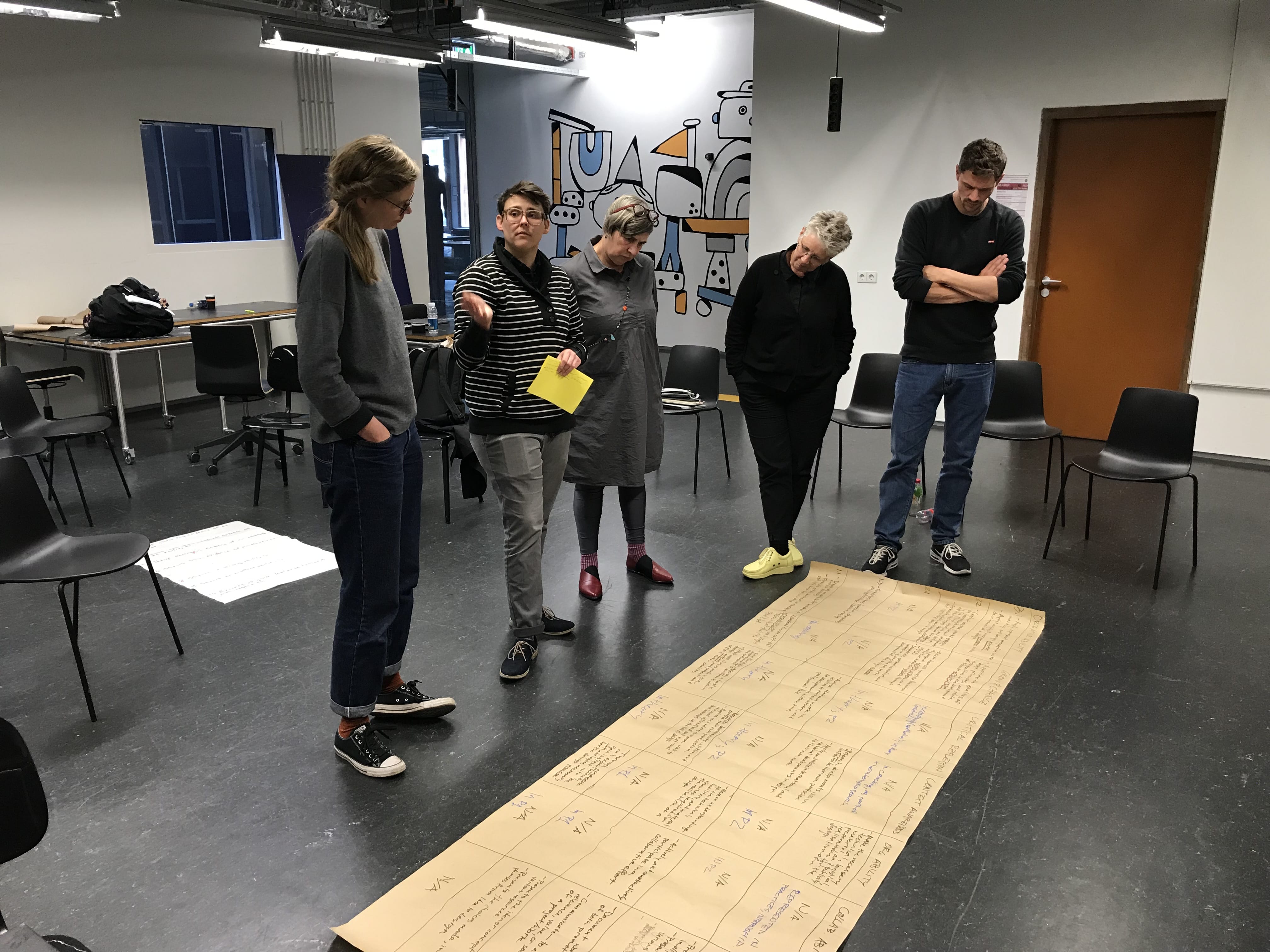

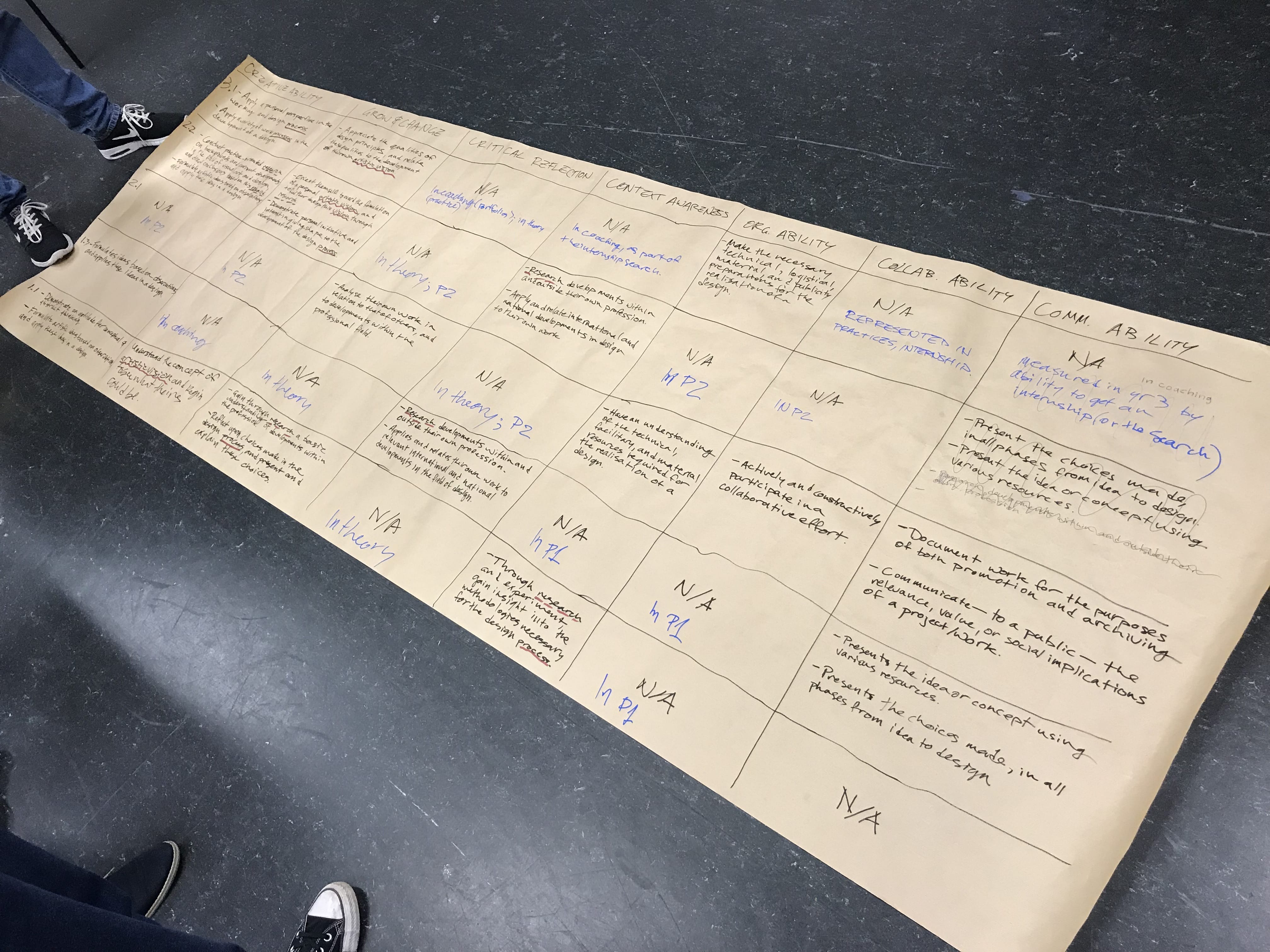

Major team meeting discussing competency division across terms.
Other Assessments During the Study
In connection to the backbone of Competency Assessments, the system provides a large diversity of formative and summative assessments, evaluations and reflections as part of the programme’s educational structure. They measure the students’ performance in projects and other specific activities designed to let them achieve the intended level of competence. Learning goals and intended outcomes of specific projects and other study activities are described in the Curriculum Descriptions, aligned with the assessment methods and criteria that come with them.38
The WdKA actively uses an Assessment Policy and Planning Document (updated whenever the programme and assessments change), to establish the system of student assessments, its components and planning. The document describes the formal frameworks of assessments, including the Competency Assessments, as well as the role of every participant in any of the assessment procedures and refers to relevant underlying documents (e.g., Course and Examination Regulations)39 or other related documents (e.g., the online Students Graduation Manual). Both the Fine Art and Design programmes use the same overall framework as described in the Assessment Policy and Planning Document.40 The assessment policy and planning aim to present students with a diversity of methods of assessment, to help them and their tutors evaluate progress and learning achievements, and to train the students for future practice. An assessment can combine two or more methods to obtain a multifaceted view on the student’s integral achievements.
The Curriculum Description (Onderwijsaanbod), designed for the teaching teams by programme representatives in collaboration with the Curriculum Committee, provides learning goals and assessment criteria to be used by the teaching team while compiling the Lesson Plan (Lesaanbod) for the students.
The assessment framework provides for:

"Walter works with a lot of different companies. And together with another intern, we had a lot of contact with them. Now I know where to find the good companies that are producing samples and other stuff. That was a bonus that I didn’t expect to learn."
Mickey Nerrings, fourth-year student, Autonomous Practices/Fashion Design Major, interned with Belgian fashion designer Walter Van Beirendonck
Each specific component of the programme has its dedicated assessment method or combination of methods, according to the intended learning outcomes, the student level and experience and the chosen study path.41
Quality & consistency of assessments
The Assessment Committee, under the mandate of the Examination Board, independently evaluates assessment procedures and results of the Fine Art and Design programmes. The Committee decides which procedures to focus on. Recently, the Committee produced advice on (aspects of) the Graduation, the Plus week assessments and the Assessment Policy and Planning Document. Consistency and assurance of the intended level are the main concerns of their advice.
In reconsideration of its own position, the Assessment Committee is transitioning from only auditing and monitoring procedures to a culture of care as well, advising Course Leaders and curriculum design teams on the enhancement of the assessment processes.
Assessment of larger study components, like projects, are never performed by individual tutors, but by tutor teams. Results of these components (designs, visual works, concepts) are usually displayed for presentation purposes, supporting fairness through comparison.
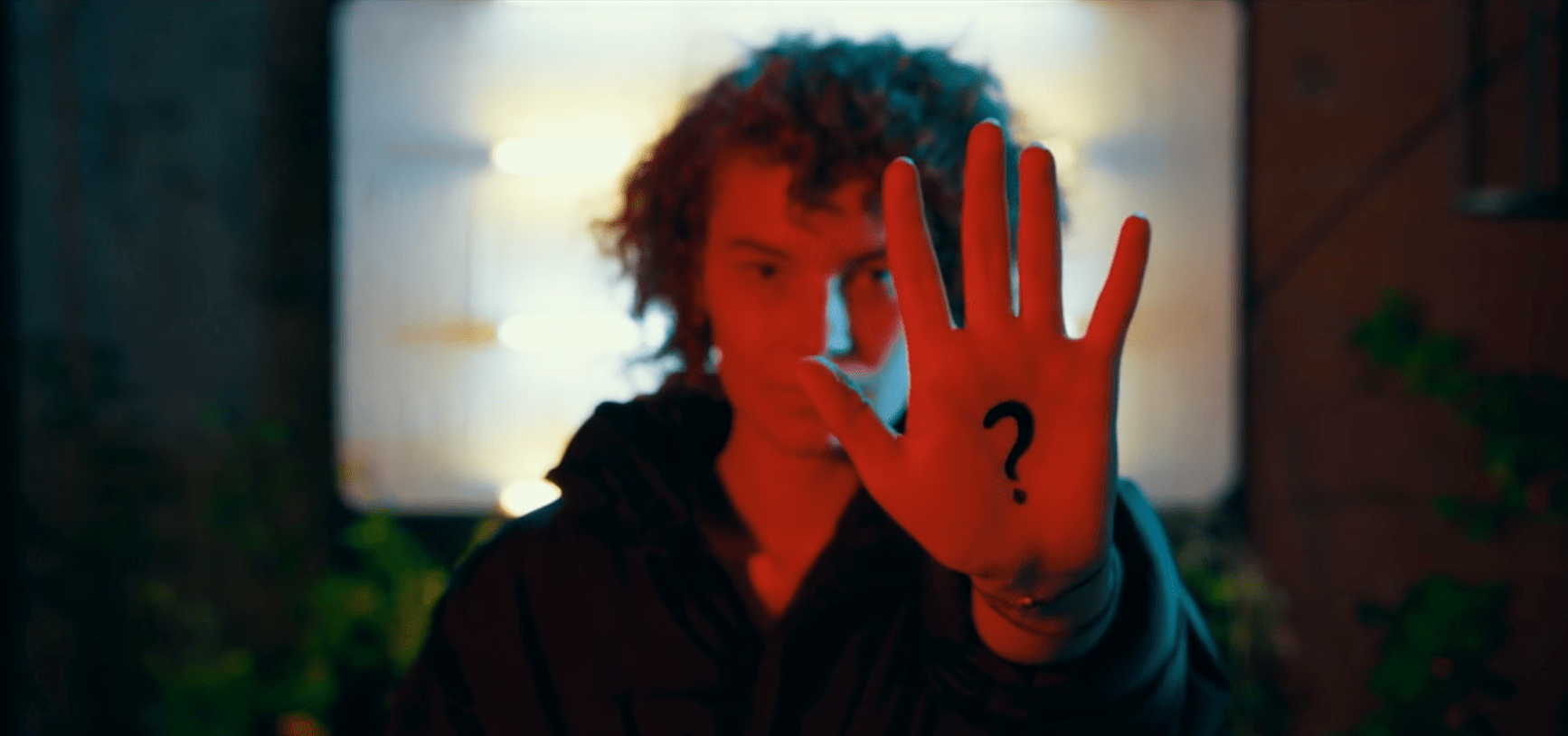
"I really wanted to be in a school system where I could be level with the teacher. I didn’t want to be seen as simply a number that needs to follow strict rules. At the WdKA, teachers see you as an equal designer. You don’t experience boundaries between the tutors and students. The teacher has to know you to be able to help you. If everyone needs to do the same thing, in the exact same way, it is likely not going to work because everyone is different."
Louisa Teichmann, fourth-year student, Autonomous Practices/Graphic Design Major
Research projects as part of the graduation process are subject to calibration sessions amongst the assessing tutors, who share opinions on the level of a selection of actual course work and establish a form of consensus about assessment and marking. Minutes from these calibration sessions are shared with the Examination Board.
The Education Station provides the initial and annual (re)training of the Competency Assessors. These training sessions include calibration sessions and use the input from evaluations of previous assessments. During this course year (2019), 24 tutors started the SKE course (senior assessment qualification, 70 hours) and 54 tutors started the BKE course (base assessment qualification, 60 hours). All tutors have to have at least a BKE qualification in 2020.
The grading system varies with the assessment methods and is aligned with the intended learning outcomes. A numeric system (1 to 10) is used for most projects and for theory and examination components. A pass/fail grading system is used for Competencies, Plus weeks and some Practice projects. 42
All assessment results are recorded in the Osiris administration system and feedback forms can be accessed by the student on MyWdKA. Also, the results of the CAs are orally substantiated when communicated with the students. Students are encouraged to discuss and actively use feedback in their subsequent study activities, preferably by letting the processing of earlier feedback be part of the next assessment.
Evaluation & Improvements
This elaborate and impactful series of Competency Assessments has proven its value in the conscious artistic and professional development of the student. Based on the nationally and internationally established competency sets, it provides a systematic and comparable framework of assessments from the moment of admission to qualification for the bachelor’s diploma.
As an integrated component of the programme, fully embedded in the student’s pathway of development, the Competency Assessments contribute to clear and realistic views on achievements, progress in learning and positioning towards professional requirements. The fact that the carefully trained assessing tutors are not the student’s tutors at the moment of assessment, greatly helps in maintaining objectivity in the overall view of a student’s progress and development, and also informs the tutoring colleagues about the effectiveness of their teaching. Annual evaluations contribute to refining assessment procedures. The gathering of quantitative information of the results informs tutoring teams on how well they are educating students to achieve the intended level of competencies.43

"Tough love. I commit myself to guiding students in their process of self-discovery and creating work that is relevant to others. That means, sometimes, to keep on asking questions until the bottom of things has been reached."
Catherine Somzé, tutor, Critical Studies in Autonomous Practices
The WdKA sees Competency Assessments as the principle method of assessing students at essential moments in their study. However, in previous student feedback, they were not fully aware of the significance, process and value of these assessments, especially in the beginning of their studies. As a result, more effort was placed on communicating the process and relevancy. In April 2019, student surveys revealed a growing positive understanding of the assessments and their criteria, methodology and usefulness for the learning process. The students found the procedure and the criteria to be “clear”. The students also found the assessors to be prepared, and they could also speak freely about the competencies they had developed.44 45
Although the various assessments and their methods are adequate and provide necessary insights on which to build further study, the system as a whole is intensive, elaborate and time-consuming. The detailed grading and required administration especially, combined with the short time between assessments and the unavoidable overlaps, lead to discussions by both teaching staff and students about the necessity of all the elements in the overall structure. These considerations coincide with emerging discourse within the field of education about “over-assessment”, student ownership of the learning process, and in general, the role of uniform assessments in art education.
Future development might result in a growing emphasis on short cycle feedback and peer-reviewing, connected to a series of Competency Assessments. In that still very much hypothetical case, the Competency Assessments might have to develop into the only leading summative assessments in the program, affording the students the highest form of ownership in their learning process.
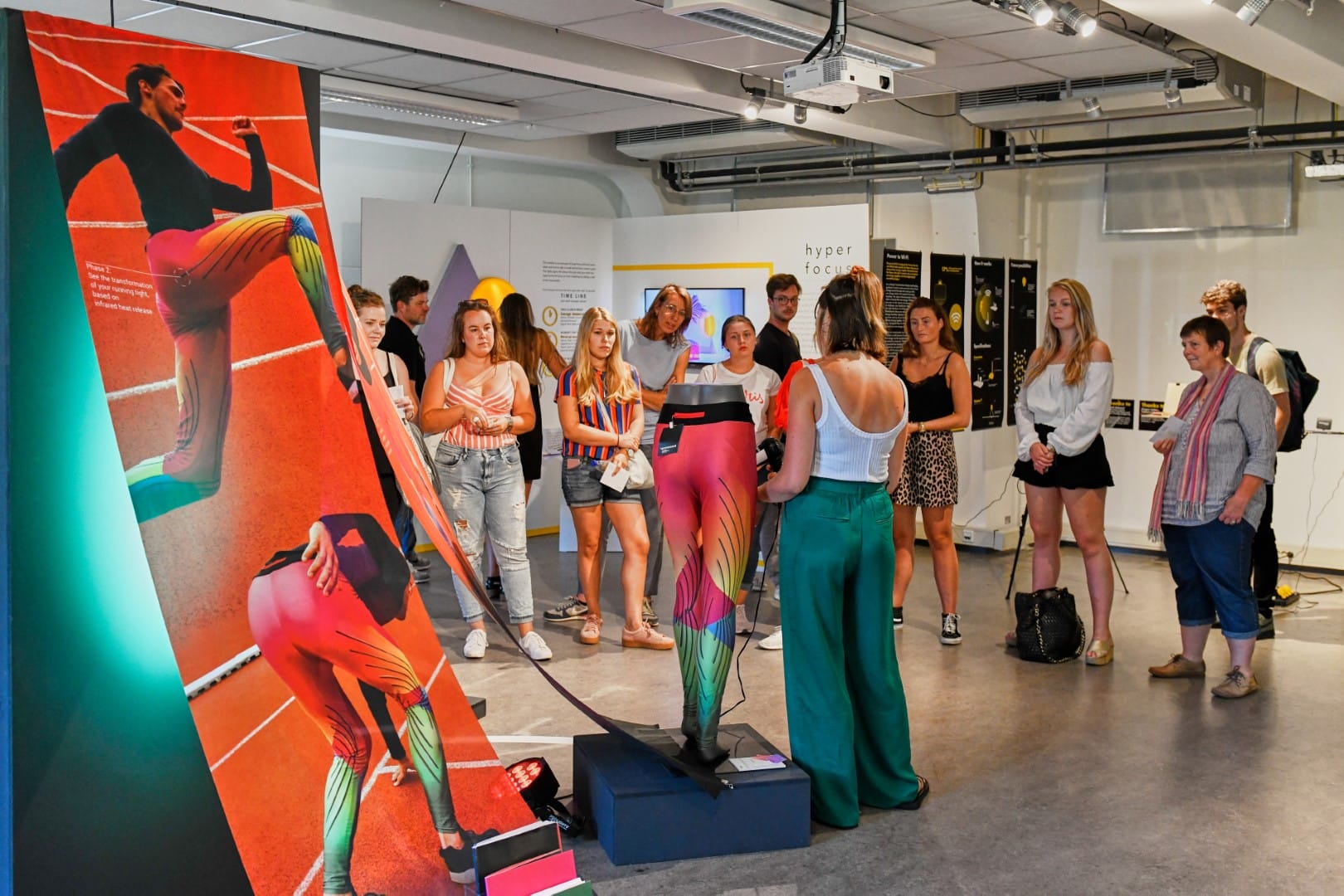
Anne Pater, Commercial Practices/Lifestyle Transformation Design, "Temperskin - The Next Performance Clothing", 2018
Standard 4: Intended learning outcomes achieved
Examination Leading to Graduation:
Knowing whether the intended learning outcomes are achieved is first measured through the final graduation process and its related assessments. At the end of every June, the buildings of the WdKA change into an even more vibrant environment as students build their final presentations for examination. They have already gone through Competency Assessment 4 and have finished their research and preparation for the forthcoming Graduation show. Our independent Examination Board, which also safeguards the enforcement of the Course and Examination Regulations, appoints examiners. Practice Coordinators nominate External Examiners, who are representative of the orientation of the student’s selected Practice and are exemplary in their fields. A Research Tutor and a tutor from the student’s selected Major are the only two internal examiners, and to retain objectivity, only the Research Tutor is directly involved in guiding the student.
The formal procedure is articulated and updated annually in the Course and Examination Regulations.46 A detailed description of the procedures of graduation is also available online at MyWdKA. There, students can find the graduation guide for Fine Art and Design, which describes learning goals, assessment criteria, overall components of the graduation trajectory, requirements for their project plan, the requirement of an external partner, requirements for their research document/project, final exam project, graduation presentation/exhibition, CA4 and the integrated evaluation of research and practice.47
The examination itself is a multifaceted process, starting with the final Competency Assessment (CA4) which takes place approximately three months before the actual graduation date. Assessed against the full set of bachelor’s level qualifications, the student continues researching and getting feedback on their final projects until they are evaluated by the team of graduation examiners. The combination of CA4 and the graduation examination connects all competencies to the actual achievement in the exam work and presentation, ensuring that the student operates at the bachelor’s qualification level.
Passing the Competency Assessment allows the student to continue in the examination process: delivery of the Research Project (7 EC) and Final Project (7 EC). The Research Project has to be documented and delivered in a research document, prior to the delivery of the Final Project. The Final Project has to be delivered in a standalone exam presentation of the finished works. The appointed examiners will assess both interconnected projects.
The representative of the Major (examiner and chair of the examination team) introduces the examiners to the student’s standalone exam presentation. The examiners can decide to gather extra information from the student, who is invited to stand by. The Research Tutor, the Major representative and the External Examiner together have to arrive at a conclusion and a mark for both components in a discussion that follows the examining of the presented works. The conclusions of this discussion are archived in the Graduation Assessment Form, which also shows the marks for both the Research Project and the Final Project. The grading scale runs from 1 to 10, with a 6 and higher being sufficient. The External Examiner co-assesses both projects and observes the examination procedure and the quality of judgement.
Apart from the presence of External Examiners at every individual exam, the Examination Board invites observers, national and/or international, from comparable programmes to visit ongoing exam presentations and discussions. The observer(s) report their findings afterwards as part of the evaluation of the exam procedures and results.48
Members of the work field are invited to visit the exhibition (for example, as jury members of the Drempelprijzen [Threshold Prizes]) and share their findings with the responsible programme leaders. Several national publications have reviews of the Graduation shows in the Netherlands, or special reports on some of them.
In the graduation process, the student is urged to involve an external partner, connected to the field of research and final work, to ensure relevance of the projects. This external partner discusses the progress and level of the developing projects with the student on a more informal level and does not participate in the formal examination procedures. External partners serve as critical soundboards for individual students.
In researching and developing the exam project, the starting point lies in the Practice the students have chosen. In their Minor, students have already chosen their area of interest and worked in relation to their selected Practice. Although the Minor is a separate study component, students can use research and other results, as a starting point for their graduation projects. During graduation, students show how they connect the Major of their study with the Practice of their choice, positioning themselves in the professional field. The student decides how and to what extent this relationship is shaped in the final projects.
With their Major skills and knowledge firmly embedded in the Practice environments, in their Graduation Project the students show meaningful connections between their individual take on their profession and an actual field of practice. Graduating within the Practice context means the student relates to one of the actual challenges or questions the Practice programme raises and takes an artistically driven position in a relevant societal field. This positioning, and the demonstrated skills and insights, goes beyond the creative industries as future practice environment: it can also include other important fields like healthcare, social movement, urbanisation, environmental challenges, human relationships, food or artificial intelligence.
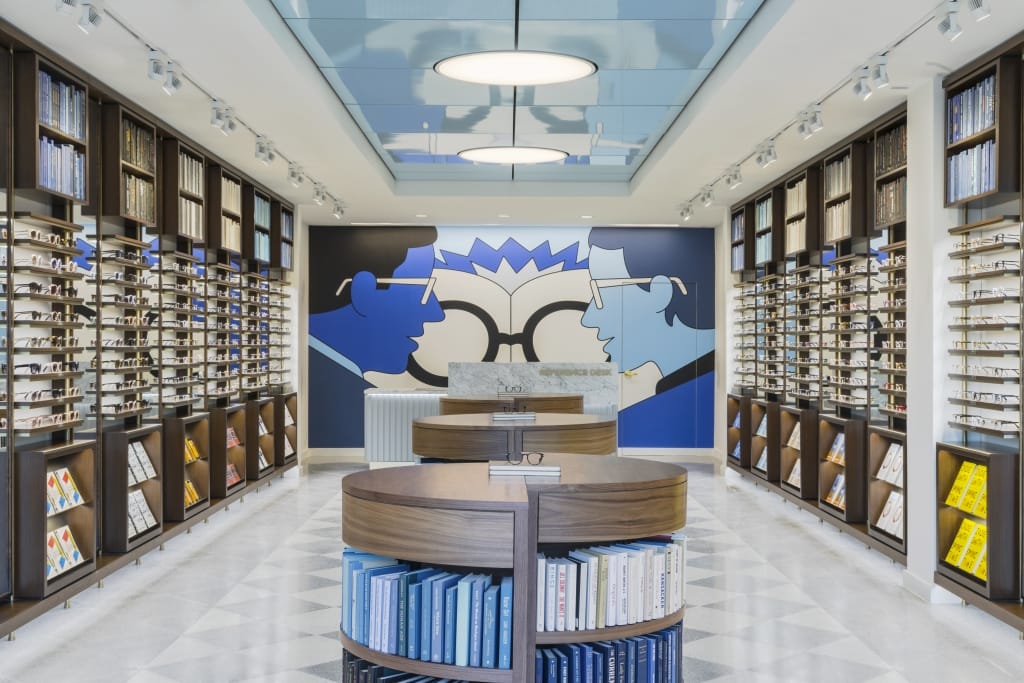
I recently designed the facade and interior for a new Warby Parker store in Houston, Texas. It's the largest project I have done so far in terms of scale and people involved. People will be working in this store daily, and as a person who is affected by my surroundings, I tried to make the designs both appealing and tranquil, contributing, hopefully, to a pleasant space to be in for the employees of the store.
Seb Agresti, freelance illustrator and designer whose work has appeared in The New Yorker and Daz Magazin, graduated 2015, Illustration/Social Practices
Alumni Achievements
Another way we measure whether we have accomplished our intended learning outcomes is through the achievements of our alumni. We see alumni actively develop their careers in the field of their Major studies, often influenced and inspired by their interdisciplinary Practice learning experiences. It is important to note that our graduates do not only choose professions from existing ones (e.g., graphic designer, animator or independent artist) but also claim, and by that, invent their own unique and new segment of the market for their own product or service. Because the box of one specific major does not contain the full range of their professional aspirations, they often invent a name for their occupation that reflects this range accurately. They call themselves: in-betweener, habitat shaper, artist-around-the-clock, sustainable process developer, experience designer, hybrid creative, awareness cultivator, relational therapist of people and things, experience storyteller, media landscape architect, master of unusual materials, mythic narrator, social healer, identity demystifier, awareness creator, and sustainable mind-set designer. 49
Next to our alumni survey, which is sent out every two years and asks about employment and activity, the WdKA interviews selected alumni about their study experiences, current employment and activities.50 We try to have close ties with our alumni by inviting them to events such as Station Day, Beyond Social, Autonomous Fabric and the Graduation show, and let them contribute to these events, when possible. They are nominated for prizes granted by outside partners, such as the Drempelprijs and the Henri Winkelman Award (for entrepreneurship in art and design). This latter award, with its winners and nominees, illustrates the impact of our young alumni on the professional field. With its rigorous criteria on entrepreneurship, authenticity and impact on the professional field in mind, the Practices nominate their candidates. In public pitches the nominees reveal their achievements and their future plans to the external jury of cultural entrepreneurs.
Autonomous Practices Alumni
The Autonomous Practices encourage their alumni to become catalysts in opening up artistic fields that previously were out of reach. As these fields are sites under development, they may be overlooked; but they can also be explored and are often full of potential and possibilities. Autonomous makers are able to critically engage with contemporary challenges, rather than taking them for granted; and most importantly, they are able to bring these challenges back to a personal level. They are able to come up with intelligent and practical responses – to disrupt systems, to find loopholes, to appropriate and make things their own.
As members of collaborative self-organising practices within the Autonomous Fabric in Rotterdam, our graduates show their work at V2_Lab for the Unstable Media, TENT, Showroom MAMA, Kunsthal, Het Nieuwe Instituut, and other high quality venues and galleries in Rotterdam. They also contribute to exhibitions and events at Eye Filmmuseum (Amsterdam), Galerie Ron Mandos (Amsterdam) and the International Documentary Film Festival (Amsterdam). Their works have been published in Vogue, NRC Handelsblad and Trouw, and have been shown at the Netherlands Film Festival and the prestigious International Film Festival Rotterdam.
Our alumni work professionally as independent artists, moderators, editorial assistants, art directors, poets, multimedia artists, writers of fiction and non-fiction books, (animation) filmmakers, documentary makers, commercial photographers and junior creatives.
Social Practices Alumni
We see the alumni of the Social Practices actively develop their careers in the field of their Major studies, often influenced and inspired by their interdisciplinary Practice learning experiences and pending demands of society and the world. As socially engaged artists and designers, they contribute to society in a large variety of ways: in community contexts such as Bouwkeet, Driessens & van den Baar Wandschappen, Afrikaanderwijk Coöperatie; in studio contexts such as ‘Branding a better World’, Afdeling Buitengewone Zaken, Studio Dirk Van der Kooij; at podia such as What Design Can Do, TEDx, Mediamatic, Pakhuis de Zwijger; in media outlets such as De Correspondent, VPRO De toekomstbouwers (future builders), NPO (Dutch Foundation for Public Broadcasting) television and radio appearances, BNNVARA, Brandpunt+; as filmmakers or animators at, for example, Korrel Film and VPRO Tegenlicht; as graphic novel illustrators (e.g., “Europe’s Waiting Room”); as embedded artists and designers in municipalities, Ministries (of Health, Welfare and Sport, of Education, Culture and Science, and others) and in education at large.
As they represent a highly diverse body of (inter)disciplinary fields with their innovative perspectives, a large amount of alumni create independent or new practices: for example, Living Light Plant-e, The Great Bubble Barrier, Kids of the Universe, Zeeboerderij-IJmond, Tattoo Studio Ace of Hearts, Buro Ponzo, Isaac Monté and Studio Nienke Hoogvliet.
Our alumni work professionally as independent artists, researcher and practitioners: Noa Silver is a digital media artist and has exhibited at V2, KunstRAI, Showroom MAMA (2018), with work concerning interaction, sound and Artificial Intelligence; Kaili Smith, winner of the Sober Talent Award, has exhibited his work at Spoke Art Gallery (New York), Thinkspace Gallery (Miami) and Honolulu Museum (Honolulu) (2017, 2018); Roxy Caprilles was the winner of the Drempelprijs 2016 and nominee for the Dolf Henkes Prize 2018. She co-led the ‘All you can Art’ project at the Kunsthal (2018), and exhibited at TENT, Rotterdam 2019; Berend Brus started the fashion label Berend Brus; Stacii Samidin, winner of the Rotterdam New Talent Award 2018, works worldwide as a photographer and filmmaker, with exhibitions at the Nederlands Fotomuseum, the Rijksmuseum Amsterdam and De Kracht van Rotterdam, and is currently nominated for the Henri Winkelman Award 2019; Eliza Bordeaux, works as a photographer and has exhibited at the Nederlands Fotomuseum (2018), and was a nominee of the Steenbergen Stipendium 2018 and winner of the Jury Prize De Kracht van Rotterdam (2019); Harmen Meinsma works as a photographer since 2017 and his work has been published in Vogue NL, &C, i-D, Adformatie, AD, NRC and Trouw.
Commercial Practices Alumni
The alumni of the Commercial Practices apply their talent to radical innovation. Inspired by the present and the future, they promote innovation and transdisciplinary connection via different podia. For example, Jasna Rokegem delivered a TEDx talk on smart textiles that transform in response to the needs of the body. Today, she is cooperating with companies all over the world such as Nokia Bell Labs, Nanex Company and Leap Motion. Amy Guijt has her own graphic design bureau dedicated to making data visualisations that lead towards a better work/life balance. She created a diagnostic ‘Toolkit Hard Facts, Soft Interpretations’. Collaborating together, Merel Klomp who graduated from Lifestyle Transformation Design and Elmar Janse who graduated from Graphic Design founded the creative agency Encrite, which helps new brands profile themselves through design and film. Some alumni go on to create new materials, such as Koen Meerkerk and Hugo de Boon who started Fruitleather Rotterdam, and Emma van der Leest who is a biodesigner, founder and creative director of the BlueCity Lab, which researches and develops new materials from bacteria to waste streams. Simone van Oosterhout and Jerry Estié engage technology to contribute to a healthier and safer social environment. Stephany Caparn’s work questions established representations through photography. She has been nominated for the 2019 Harry Penningsprijs by Pennings Foundation and in 2018, was nominated by Fotomuseum Winterthur as an emerging artist. Anne Pater has her own design bureau and has worked for clients such as SKNDAL, Zalando, Poederbaas and Dijk Natural Collections. Sonny Op Stap finds smart ways to improve events, performances and parties. Others run independent studios such as Studio Vormlust and Sharon Vos, while others collaborate with museums and municipalities such as Studio Bureau, or work on personal in-depth research and share knowledge with different art and media institutes such as Mick Jongeling. In other words, alumni from the Commercial Practices are widely spread over diverse fields and markets, they are self-employed and have positions within teams of larger corporations.
Master Study & Alumni
Alumni have been awarded master’s degrees from the Design Academy Eindhoven (Contextual Design, Information Design), Sandberg Institute (System D Academy, Design), AKV/St.Joost (Photography), ARTEZ (Werkplaats Typografie), Piet Zwart Institute (Experimental Publishing, Interior Architecture Research + Design, Education in Arts), Rotterdam Academy of Architecture and Urban Design, Delft University of Technology (Architecture, Urbanism and Building Sciences), Utrecht University (New Media & Digital Cultures: Gender Studies), University of Amsterdam (Artistic Research), Erasmus University Rotterdam (Media and Journalism), University of Ghent (EU Studies), Sint Lucas Antwerpen (Visual Arts), Goldsmiths, University of London (Research Architecture: Visual Cultures, Cultural Studies), Central Saint Martins (Fine Arts), University of the Arts London (Advertising), Royal College of Art London (Art and Design, Print), Manchester School of Art, Metropolitan University (Graphic Design and Art Direction), University of Edinburgh (Design Informatics, Contemporary Art Theory), Hyper Island (Digital Management), University of Applied Arts Vienna (Social Design), Polimoda Milano (Fashion), Parsons (Fine Art), amongst many others.
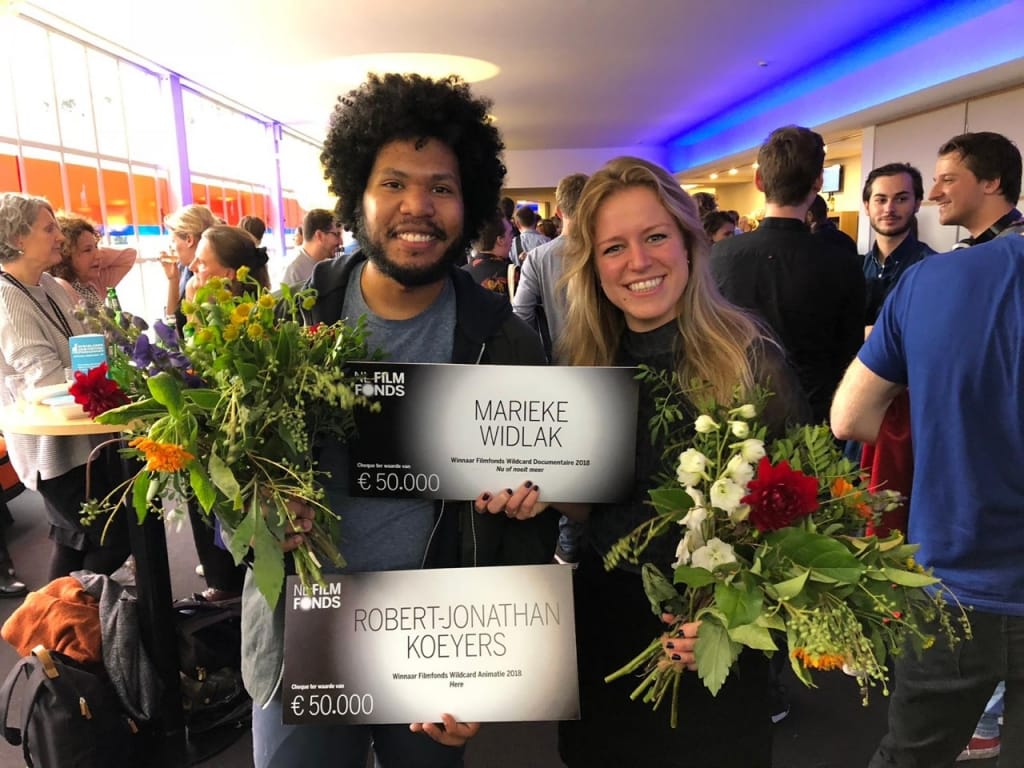
Winners of Filmfonds Wildcards 2018: Robert-Jonathan Koeyers (Autonomous Practices / Animation and Marieke Widlak (Social Practices / Spatial Design)
Awards & Recognition
Alumni have been awarded prizes such as the aforementioned Drempelprijs (Threshold Prize: Autonomous, Social and Commercial), Research Award, Maaskant Award (Internationalisation) and Henri Winkelman Award (Entrepreneurship), which are awards organised by the WdKA but funded by others. In addition, they also win prizes connected to their professional careers: Steenbergen Stipendium (2015, 2017), Dutch Film Fund Wildcard (2018, two alumni each won 50,000 euros), Rotterdam New Talent Award (2018), Rabobank Dutch Photographic Portrait Prize (2018), El Hizjra Literatuurprijs (2018), Olympus Young Talent Award (2017), Tuschinski Award (2017), De Kracht van Rotterdam Award (2019), VPRO Guide Cover Competition (2018), D&AD Pencils Award (2017), ADCN’s Dutch Creativity Awards (2018: Digital & Social & Mobile Category Award, Direct Award, PR & Influencer Award, Experience Award, Art Direction Award, Talent Bronze Award), D&AD New Blood Award (2018), NRC Charity Awards (2018), among many others.
Evaluation & Improvements
While alumni surveys are sent out annually, only 10% are answered and returned. This does not give the overall insights into alumni activities we would like. An area in need of improvement is a more structural and effective means of tracking alumni experiences after graduation. To this end, the WdKA would like to dedicate more resources to better understand how acquired competencies within the curriculum prepare graduates for their chosen field; however, budgetary constraints have proven restrictive in terms of development on this front. Currently, for the purposes of the website, select alumni are interviewed and profiled. While also limited in scope, it has nonetheless proven useful in understanding the career pathways our graduates have chosen and the impact of our education on their work as professionals.
The WdKA and RUAS are currently working on a possible PhD-trajectory, in conjunction with RASL, which would be focused on transdisciplinary artistic research. This is being developed alongside a joint transdisciplinary master that would enrich the bachelor and master opportunities for our alumni.
At the WdKA, we are also working on bridging the gap between business and the arts. We are successful in attracting more and more entrepreneurs to the WdKA, and they are aware of the potential impact our alumni have for national and international businesses. We want to build on these relations and our activities and involve more alumni in these meetings, as well as explore possibilities of connecting them to research and enterprise.
We have plans to offer alumni studios in the Putsebocht (a neighbourhood in Rotterdam), in cooperation with SKAR, a foundation dedicated to artists and artist spaces. In this space we will have a satellite of the Business Station, which will help alumni with starting their own businesses and further help them embed their practice in the professional field.
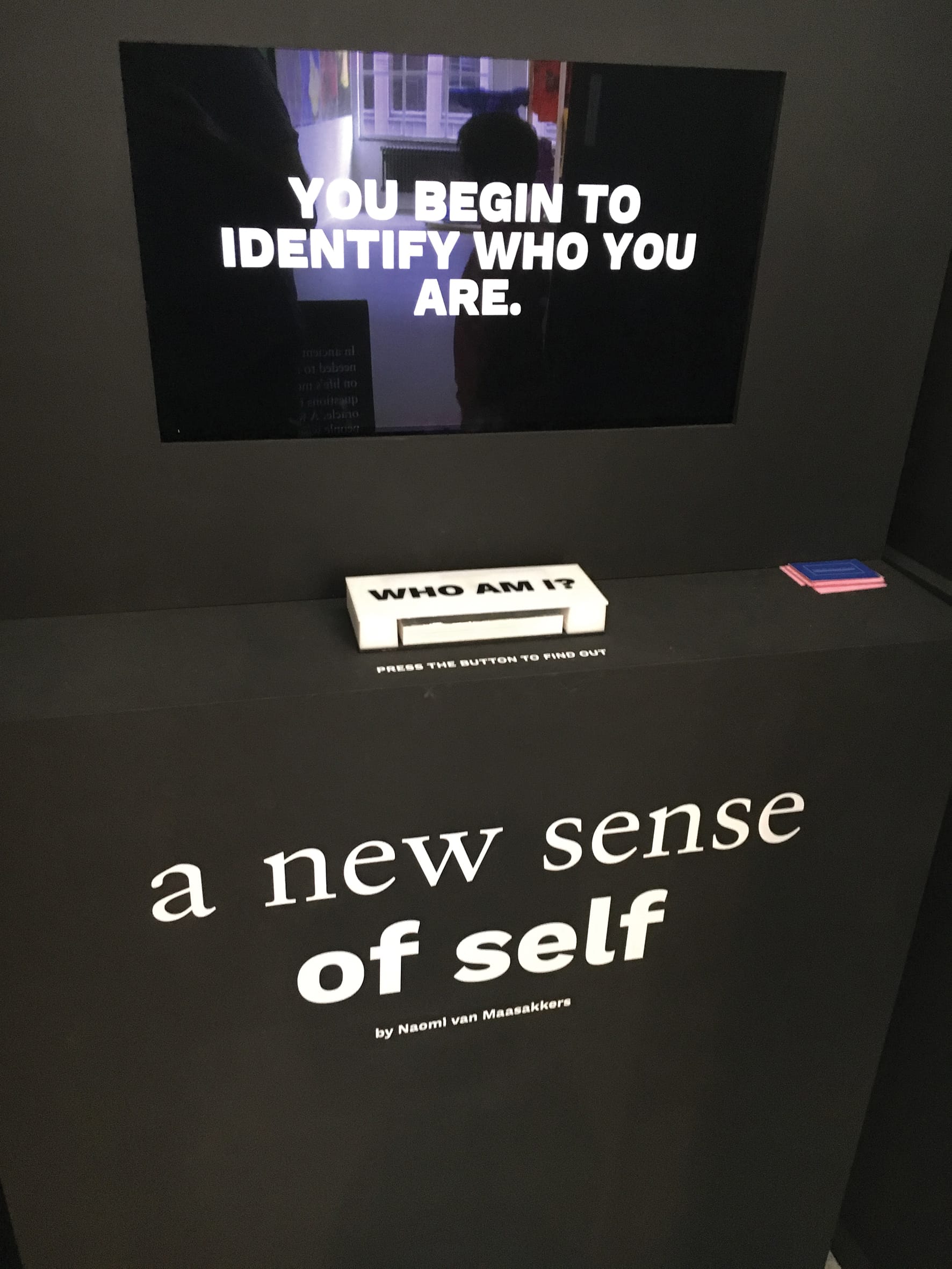
A new sense of self, Naomi van Maasakkers (Commercial Practices / Graphic Design)
Student Chapter
This section of the SER contains reflections and perspectives from students, as required by NVAO. It was created by having a diverse group representing the three study pathways, evaluate and reflect upon the programmes. Their stories and quotes are distributed according to the relevant standards of this SER. For objectivity students could speak anonymously and gave their comments to a staff member of Quality Assurance. No teaching staff were involved in this process.
General
“I like how the school is focused on your style and not that their way is the way. I find at other schools they teach you to be a certain way or to adjust to their system. The school gives you time to develop in your way but still with guidelines”
Standard 1
“Practices are a nice way to get new perspectives.”
“I think that the Practices give you a good idea of what kind of designer you can be. The only thing is that it’s still very broad and you already need to choose two in the second year. I still don’t have enough detailed information. It would be nicer if they explained more about the subjects within the Practices to get a more detailed explanation. The nicest thing about the Practices is that you can learn a lot from different majors and disciplines.”
Standard 2
“WdKA gives the opportunity to collaborate with different majors, use all kinds of media and skills that are available within the academy”
“I really like being challenged here at WdKA to experiment a lot, to learn new things, to discover myself, to know what kind of work I want to make. I like the easy approach, that I can also have fun here during the making. I like the atmosphere of the WdKA, the people and that we can work together with other departments.”
“I like the freedom the school gives us. We can experiment in the stations and approach assignments quite broadly. However, sometimes I miss depth in knowledge and concepts. We talk a lot about our work, but I’d like to have more supporting theory with the projects. Would like not having ‘theory’ as a separate subject. The teachers do provide help once you ask, and give valuable feedback. They might be a bit more critical though.”
“I like that the current curriculum gives us the opportunity to work outside of the main focus of our major (by this I mean we are allowed to work in the stations). It also helps that the instructors in the stations are open and helpful.”
“I feel that we could focus a bit more on technical skills, to really learn as much as we can. I enjoy the conceptual thinking part, but would like to make and learn these other skills at the same time. We are very free to do things with different departments.”
“The course is really architecturally-focused and we understand this is the base of spatial design. Teachers are well-informed/up-to-date, but more abstract terms/installations (e.g. sound, light, touch) would be good.”
“The teachers know a lot and have the capacity to teach us a lot. The feedback from teachers is very helpful. I learn the most from this. I therefore try to ask for feedback as much as possible. This allows me to challenge myself. The teachers also strongly encourage me to try new things, to make more, etc. Because of their questions, I will also ask myself questions.”
“We also had a moment when we, as a class, gave feedback to the teachers because the assignments became too much and the communication between the teachers was very poor, so we suffered as a result. We then raised this issue and the teachers were positive and willing to make changes (they were aware of it).”
“All teachers are also active as professional artists/designers next to being teachers.”
“Academy facilities: great! You can learn a lot of different crafts, and there are a lot of work places. You are really encouraged to learn new skills. The shop, with new opening times, is also a very nice thing to add to the academy.”
Standard 3
“Competency assessments help with reflecting on past works but they feel too spread out into different ‘competencies’ which do not always relate to each project/assignment. The competency assessment also does not feel personal, but rather as something passed down from above (Hogeschool Rotterdam, Government etc.)”
“The competency assessments are a good practice to reflect on yourself and how to look at your project. But I don’t know how to implement them in the professional field.”
“I believe that in the case of my major the feedback we received after assessments was very detailed and eye-opening. They really made me aware of how much our professors actually followed our process progress. The feedback helped me realize that some approaches I was unsure of were actually fruitful and valuable, and I became more aware of areas I am still very much lacking.”
“There are a lot of opportunities to receive feedforward/back from teachers”
Standard 4
“You get as much out of this school as you push. And if you genuinely invest in it, the teachers invest in you and it all works together to develop you as a successful designer.”
“The best thing about WdKA is: there are so many things you learn as a student here. BUT, not only as a student also as a person. I would say that everybody should at least for 1 year study at the art academy because you also learn so much about yourself!! The WdKA is a safe & stimulating place where everybody can grow into a better version of yourself!”
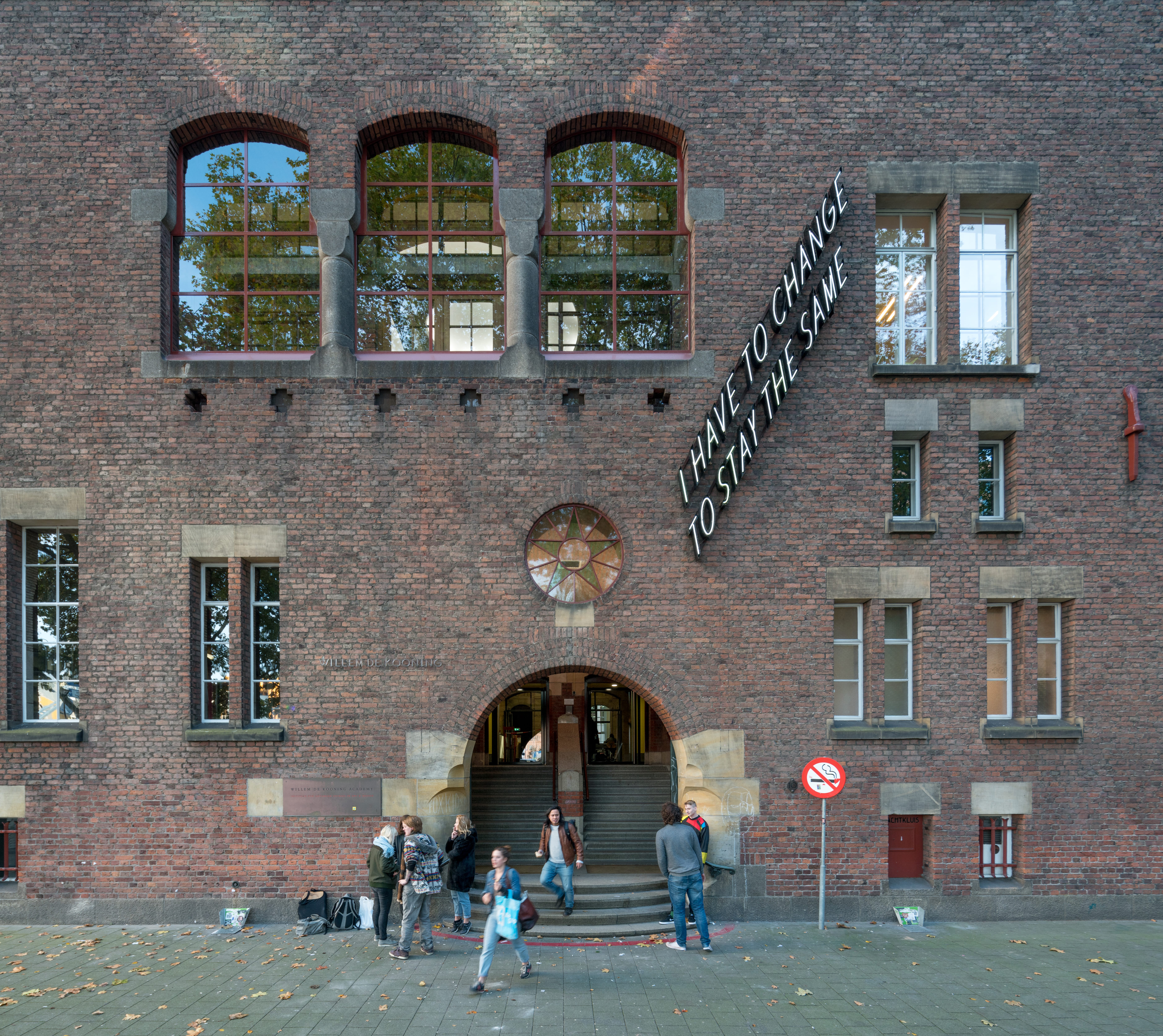
Photo: Ossip van Duivenbode
Epilogue
While we have tried to be as comprehensive as possible in this SER, the WdKA is a living organisation. Our educational and research institute is and must continue to be, a dynamic and responsive organisation, of which the many parts together constitute a greater whole. Above the main entrance to our academy, there is a famous quote by the artist Willem de Kooning that says, ‘I have to change to stay the same’. Creativity and innovation, by definition, require taking risks, self-critique, and pushing one’s own boundaries beyond what has become conventional or familiar. This means being attentive to changes in society; being more inclusive of an increasingly diversified population; remaining open, at times even vulnerable, to our surroundings; and perhaps most importantly, understanding that these attitudes do not come from weakness but from strength, and that they provide us with mechanisms for continual growth, renewal and experimentation. These are the qualities of the Willem de Kooning Academy, which require tremendous effort, but also make it a truly exceptional place to work and study.
Alumni
Table of content
PrefaceProfile & History
Bachelors, Masters, Associate Degree & RASL Double Degree
The New Curriculum
Evaluation & Improvements
Standard 1: The Intended Learning Outcomes
Fine Art & Design Competencies
Design Majors
Fine Art Majors
Three Practices & Related Minors
Other Programmes
The Stations
Evaluation & Improvements
Standard 2: Teaching & Learning Environment
Research In Context
Teaching & the Education Station
Student Guidance & Support
Systems of checks & balances
Evaluation & improvements
Standard 3: assessments
Structure & methods of Competency Assessments CA2, CA3 & CA4
Other Assessments during the Study
Quality & consistency of assessments
Evaluation & Improvements
Standard 4: Intended learning outcomes achieved
Examination Leading to Graduation
Alumni Achievements
Autonomous Practices Alumni
Social Practices Alumni
Commercial Practices Alumni
Master Study & Alumni
Awards & Recognition
Evaluation & Improvements
Student Chapter
Epilogue
Appendixes
Abbreviations
Administrative Data
Colophon
Appendixes
↩Appendix 1: Reinventing the Art School, 21st Century
Charts & Graphs A: WdKA organogram
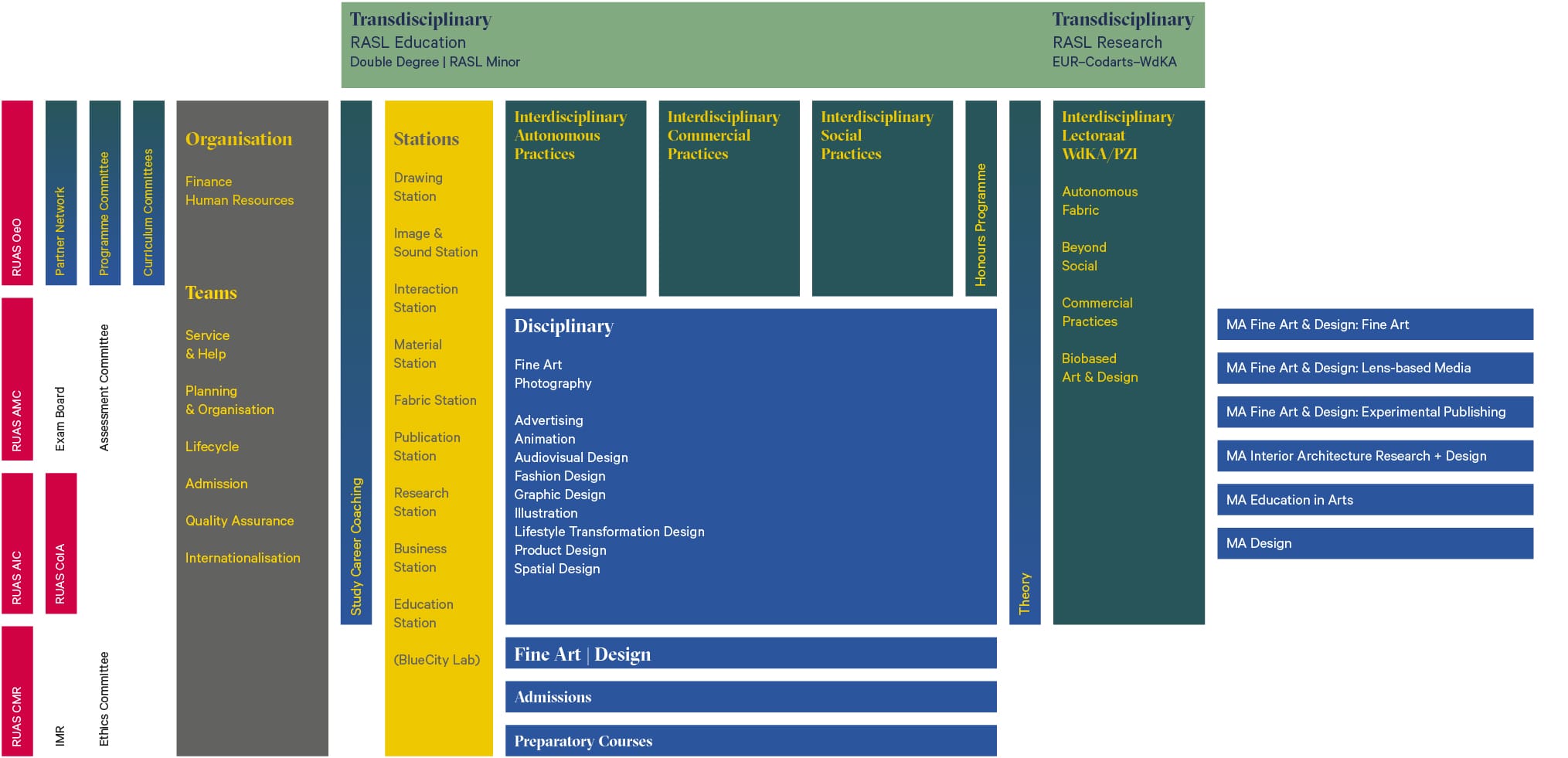
 ↩
↩
↩Appendix 2: Beroepsprofiel en opleidingsprofielen beeldende kunst en vormgeving december 2014
↩See footnote 1 in ‘After Reinventing the Art School’, Jeroen Chabot
Charts & Graphs B: WdKA Partners

 ↩
↩
↩Appendix 3: Research at the Willem de Kooning Academy
↩Appendix 4: WdKA Research Senior Lectures
↩Appendix 5: EQ Arts Quality Enhancement Report for Willem de Kooning Academy 2017
↩Appendix 6: WdKA Handbook Quality Assurance 18-19
↩Appendix 7: The Tuning Documents were the result of efforts made by a consortium of European art schools, universities and academies belonging to ELIA, a network representing approximately 250 members from 47 countries.
Appendix 7: ELIA Tuning Design
Appendix 7: ELIA Tuning Fine Art
↩Appendix 2: The OBK profile and competencies were formulated in consultation with professionals from the field, the Mondriaan Foundation, the leading national funding body for the arts and The New Institute, the leading national organisation for profiling design.
Charts & Graphs C: WdKA Curriculum

 ↩
↩
↩Appendix 8: Selection of Curriculum Descriptions:
Curriculum Description_3.1 AP Digital Craft
Curriculum description_1.1 Major Fine Art
Curriculum description_2.1 Major Fine Art
Curriculum description_2.2 Major Fine Art
Curriculum description_3.1 Major Graphic Design
Curriculum description_1.3 Major Photography
Curriculum description_2.1 Major Photography
Curriculum description_2.2 Major Photography
Curriculum description_3.1 Major Photography
Curriculum description_1.1 Major Product Design
Curriculum description_2.2 Major Product Design
Curriculum description_3.1 Major Product Design
↩Appendix 9:
WdKA competency matrix Design
WdKA competency matrix Fine Art
↩Appendix 10: WdKA position papers Practices 2018
↩Appendix 11: RUAS Honours 1819-student-handbook-f-a-h
↩
↩Appendix 12: RASL Double Degree Curricula
↩Appendix 10: WdKA position papers Practices 2018
↩It is important to note that an NWO application has been written for the Autonomous Fabric. That application which is currently being assessed was drafted with several independent art organisations.
↩Appendix 13: Curriculum Description Social Practices New Earth, term 3.1
Charts & Graphs D: WdKA Competency development
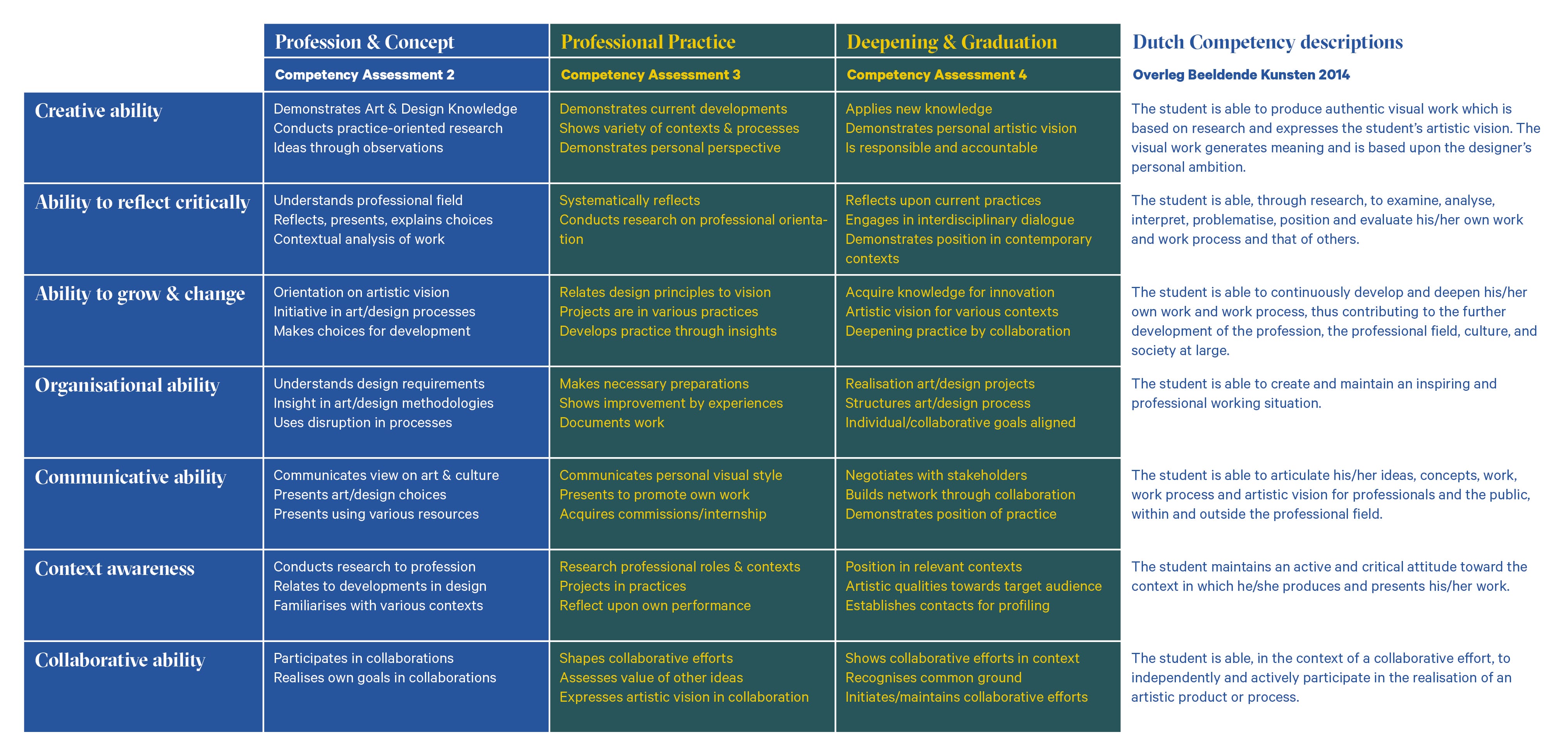
 ↩
↩Charts & Graphs E: WdKA Competencies Major-Practices
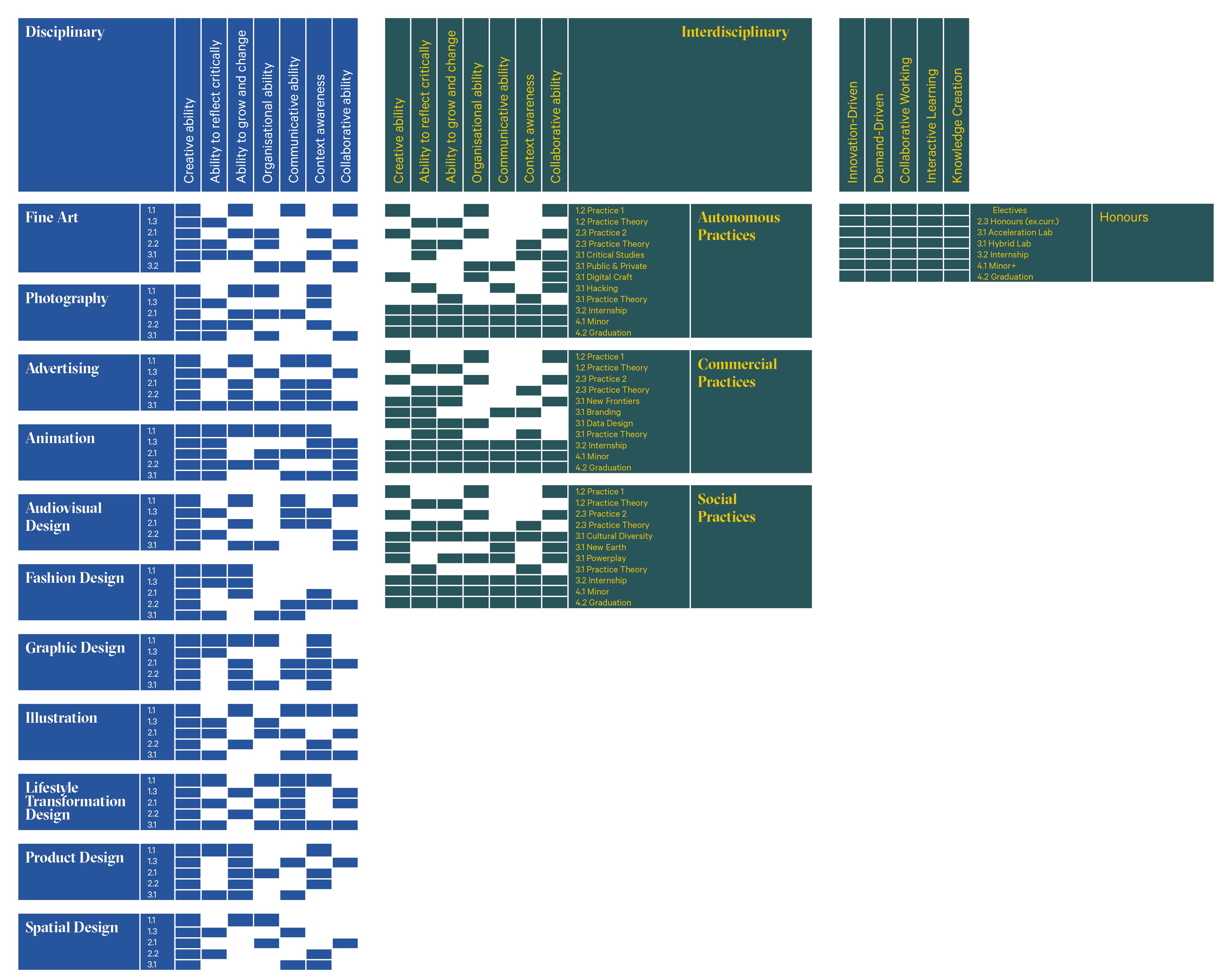
 ↩
↩Charts & Graphs F: WdKA Stations
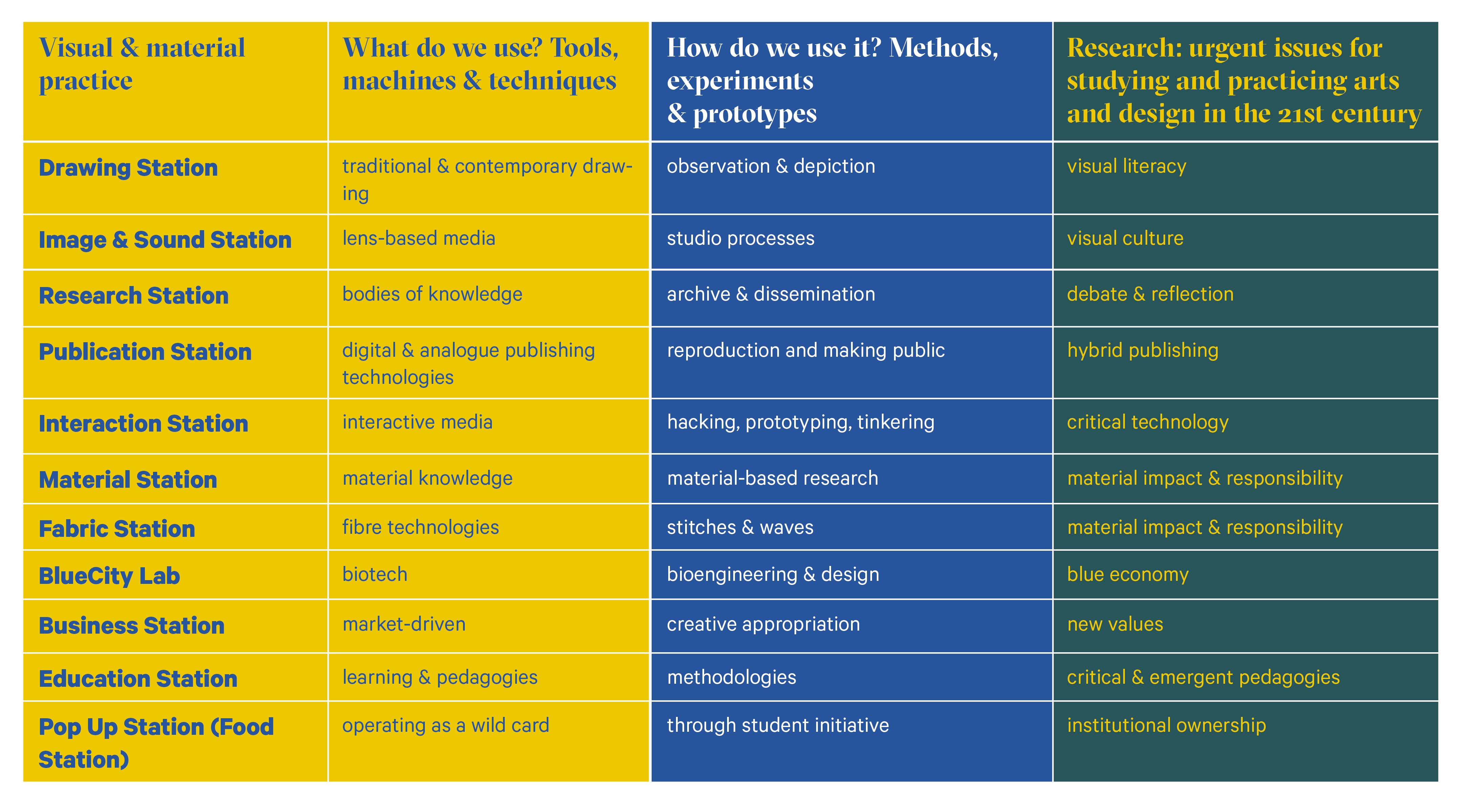
 ↩
↩
↩The NWO is the Netherlands Organisation for Scientific Research which grants research funding on a national level. Applications are rigorously peer-reviewed and standard-setting in terms of research validation and recognition. The Creative Industry - KIEM programme aims to encourage and facilitate fundamental and industrial research. Researchers can apply for funding via KIEM on behalf of consortia of companies and researchers.
↩The Hybrid Lab focuses on the hybridisation of the arts and sciences and is given direction through alternating multi-year research projects conceived within the context of WdKA’s ongoing collaborative endeavours with various partner institutes, such as RASL. Emphasis is made on transdisciplinary collaboration and knowledge creation.
↩Pictoright is the Dutch copyright organisation for visual makers: illustrators, visual artists, graphic designers, photographers, architects and other image makers or their heirs.
↩This research is lead and guided by the Research Professor Florian Cramer, Autonomous Practice Coordinator Simon Kentgens and other Senior Research Lecturers. For further information see: autonomousfabric.org
↩This Minor gives students the opportunity to engage in transdisciplinary, collaborative project-based research, in a small team of students and teachers from the fields of science, visual arts and performing arts, together with stakeholders from beyond the academy/university. The Minor is part of the innovative educational practices of RASL. While exploring a complex societal issue (the selection of the issue is student-led) in depth and from a range of perspectives, students will develop creative, critical and other 21st century skills.
↩Each staff member submits a CV annually which is archived to better understand the scope of knowledge and experience, and think through how it can be implemented across the WdKA.
↩RUAS awards PhD vouchers to a select number of candidates.
↩Appendix 14; RUAS Handreiking borgen eindniveau
↩Appendix 15: RUAS Handreiking borgen toetskwaliteit
Charts & Graphs G: WdKA Evaluation cycle
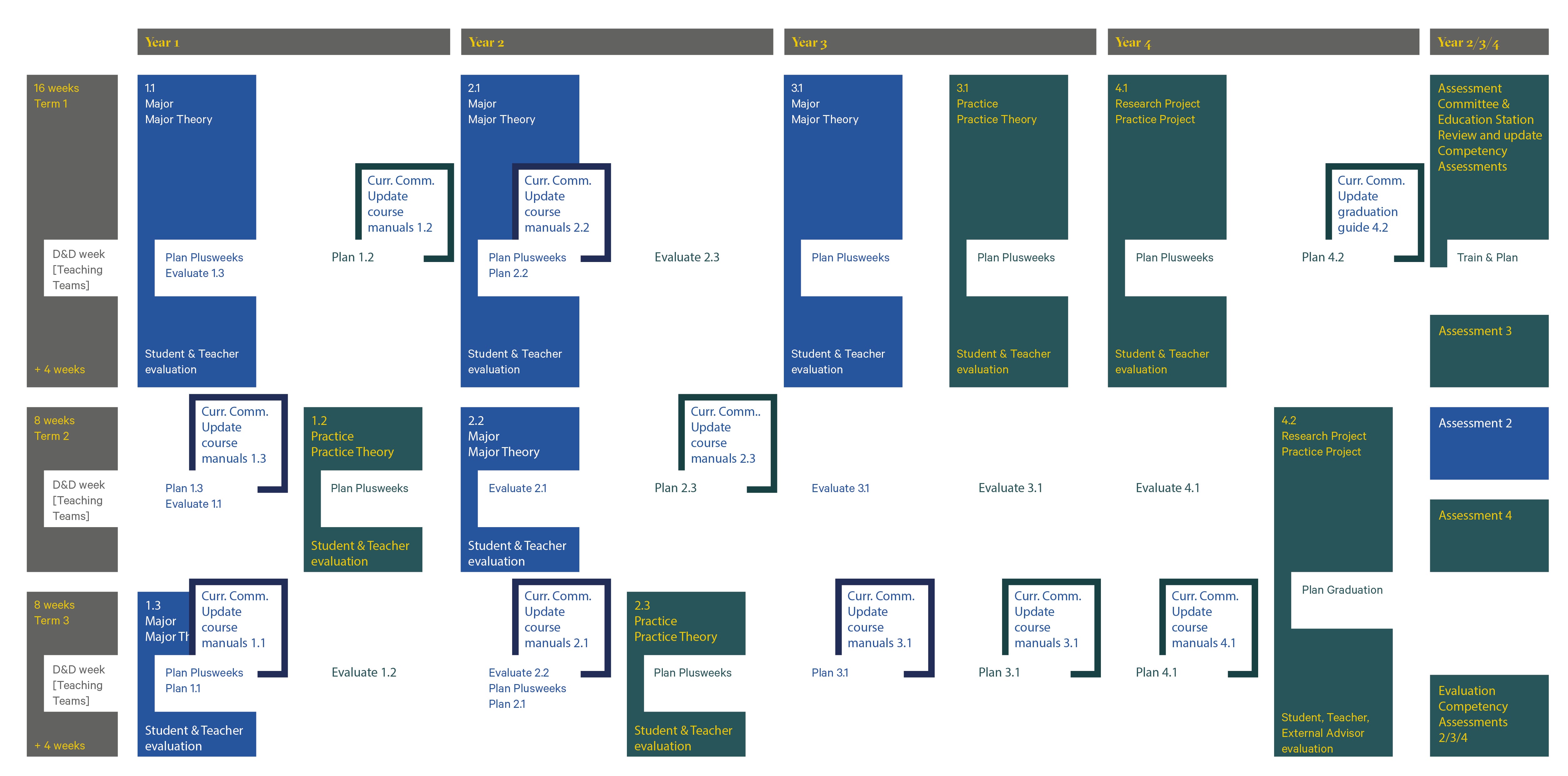
 ↩
↩Charts & Graphs D: WdKA Competency development

 ↩
↩Charts & Graphs E: WdKA Competencies Major-Practices

 ↩
↩
↩The capacity to bring in an external observer was introduced as the result of student feedback.
↩Appendix 8: Selection of Curriculum Descriptions:
Curriculum Description_3.1 AP Digital Craft
Curriculum description_1.1 Major Fine Art
Curriculum description_2.1 Major Fine Art
Curriculum description_2.2 Major Fine Art
Curriculum description_3.1 Major Graphic Design
Curriculum description_1.3 Major Photography
Curriculum description_2.1 Major Photography
Curriculum description_2.2 Major Photography
Curriculum description_3.1 Major Photography
Curriculum description_1.1 Major Product Design
Curriculum description_2.2 Major Product Design
Curriculum description_3.1 Major Product Design
↩Appendix 16: WdKA 2018-2019_Ba_Course and Examination Regulations
↩Appendix 17; WdKA Assessment Policy and Plan 2018-2019
↩See Standard 2: Teaching & Learning Environment; The Structure of the Curriculum
↩See Standard 2: Teaching & Learning Environment; The Structure of the Curriculum
↩Appendix 18: WdKA 2018-2019 CA statistics - CA chart
↩Appendix 19: WdKA Programme Evaluations Major 2.2 Product Design 18-19
↩Appendix 20: WdKA Programme 2.2 Advertising 18-19
↩Appendix 16: WdKA 2018-2019_Ba_Course and Examination Regulations
↩Appendix 21: WdKA Graduation Guide Design & Fine Art 2018-2019
↩Report by Kurt Vanbellegem (St. Lukas Antwerpen) 2018. Translated version available upon visitation.
↩
↩
Abbreviations
| BKE | Basis Kwalificatie Examinering (Basic Examiner Qualification) |
| CA | Competency Assessment |
| Centrum Beeldende Kunst Rotterdam (Centre for Visual Art) | |
| CROHO | Centraal Register Opleidingen Hoger Onderwijs (Central Register for Programmes in Higher Education) |
| D&D Weeks | Drive & Development Weeks |
| DD | Dublin Descriptors |
| EC(TS) | European Credit (Transfer System) |
| ELIA | European League of Institutes of the Arts |
| ETHO | European Technical Heads Organisation |
| GAMPSISS | Gameful Music Performances for Smart, Inclusive, and Sustainable Societies (Interdisciplinary Research Project) |
| HBO | Hoger Beroepsonderwijs (Higher Professional Education) |
| IMR | Instituutsmedezeggenschapsraad (Institute Works Council) |
| ITK | Instellingstoets Kwaliteitszorg (Institutional accreditation) |
| KIEM | Creatieve industrie - Kennis Innovatie Mapping (Creative industry - Knowledge Innovation Mapping) |
| NVAO | Nederlands-Vlaamse Accreditatieorganisatie (Accreditation Organisation of the Netherlands and Flanders) |
| NWO | Nederlandse Organisatie voor Wetenschappelijk Onderzoek (Dutch Research Council) |
| OBK | Overleg Beeldende Kunsten (National Body for Art Education) |
| OER | Course and Examination Regulations |
| PALs | Peer Assisted Learning Assistants |
| RASL | Rotterdam Arts and Sciences Lab |
| RASP | Restructuring All Study Periods |
| RUAS | Rotterdam University of Applied Sciences |
| SCC | Study Career Coach(ing) |
| SER | Self-Evaluation Report |
| SKE | Senior Kwalificatie Examinering (Senior Examiner Qualification) |
| WdKA | Willem de Kooning Academy |
| WHW | Wet op het Hoger Onderwijs en Wetenschappelijk Onderzoek (Dutch Law on Higher Education and Scientific Research) |
Administrative Data
Programme Information
Programme name:
Fine Art (Autonome Beeldende Kunst)
Design (Vormgeving)
CROHO registration:
39110 (Fine Art / Autonome Beeldende Kunst)
39111 (Design / Vormgeving)
Professional orientation and level:
HBO B Bachelor of Arts in Fine Art
HBO B Bachelor of Arts in Design
Nr of ECs: 240 EC
Status: Subsidized
Locations: Blaak 10, 3011 TA / Wijnhaven 61 3011 WJ, Rotterdam, The Netherlands
Offering Full time, four year programme
Language English
Institution Information
Name: Rotterdam University of Applied Sciences (Hogeschool Rotterdam)
CROHO: 22OJ
Status: Subsidised
Institutional accreditation: Passed in 2013, valid until 4 November 2019
(ITK result): (Review for renewal ITK took place in May 2019)
Address: Museumpark 40, 3015 CX Rotterdam, The Netherlands
Telephone: +31 – (0)10 – 794 41 41
Website: www.hogeschool-rotterdam.nl
Name authority: Mr. drs. M.J.G. Bormans, Chair of the Executive Board
Name: Willem de Kooning Academy
Address: Blaak 10 3011 TA / Wijnhaven 61 3011 WJ, Rotterdam, The Netherlands
Telephone: +31 – (0)10 –7944750
Website: www.wdka.nl
Name authority: Mr. J.J.L. Chabot, Dean